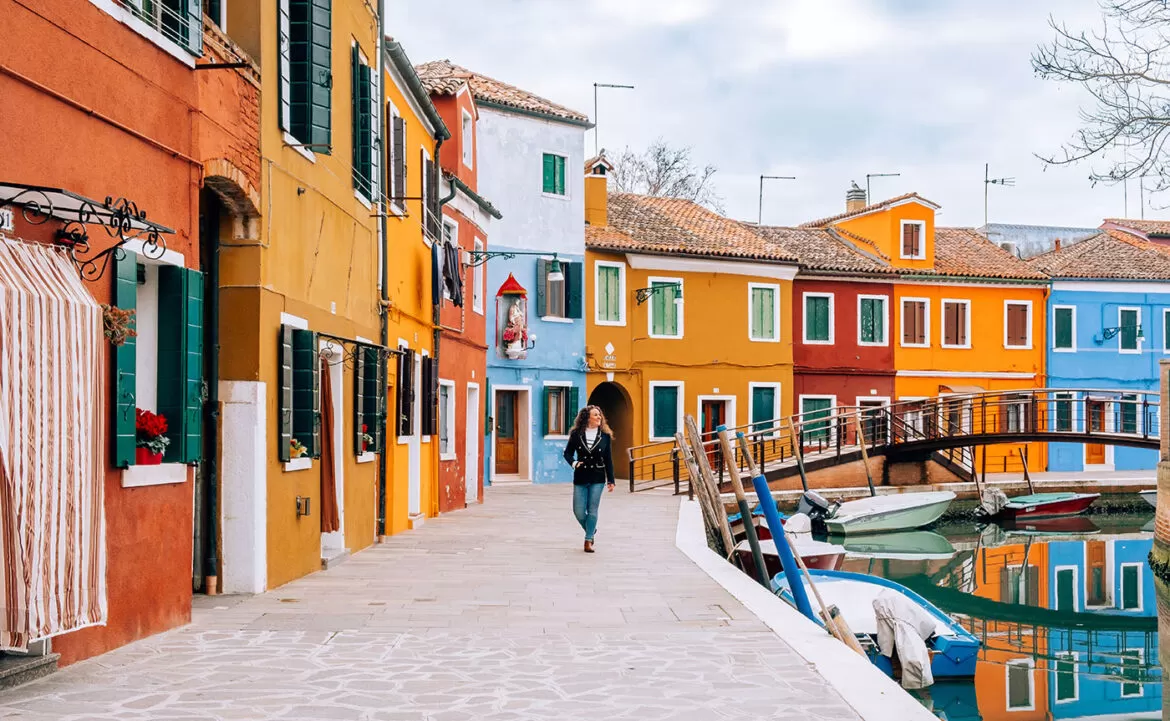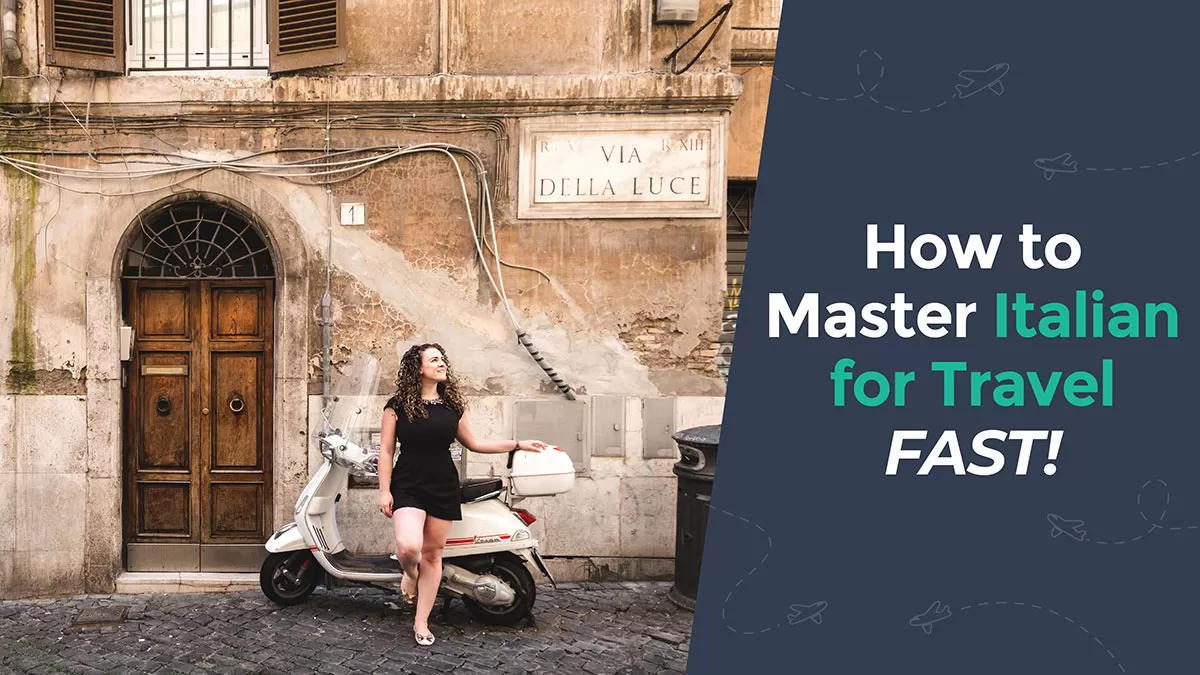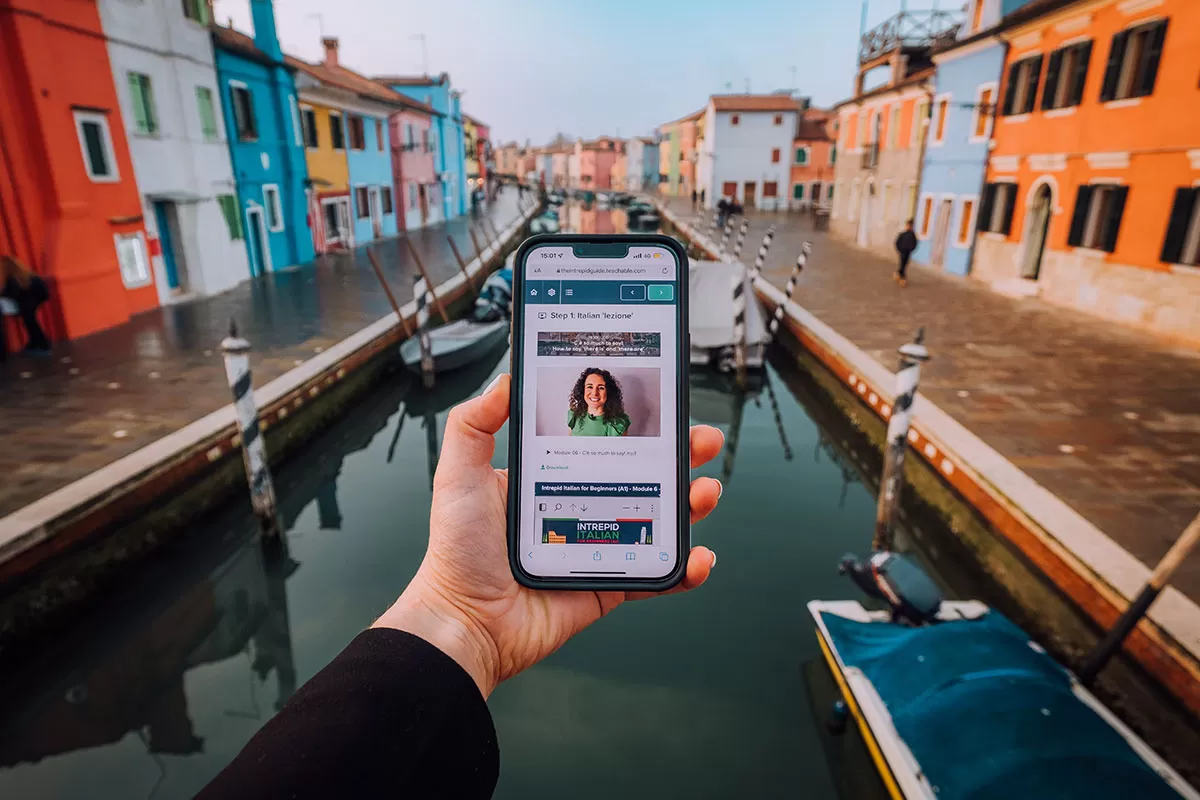Burano is a vibrantly colourful island located at the northern end of the Venetian lagoon. Made up of a group of four small islands, each island is linked together by a series of small bridges making it very easy to move around.
While most people visit Burano for a day trip from Venice, I stayed here for 5 nights and can honestly say it’s worth spending 1 or 2 nights. I spent a lot of time with local guide Silvia who was born and bred here. Through Silvia’s eyes, I saw the other side to Burano that you won’t see in a rushed day trip. With that said, this guide will help you get the most out of your visit to Burano, Italy no matter how long your visit. So, here are the 12 best things to do in Burano as shared with me by a local tour guide.
Andiamo! (Let’s go!)
A short history of Burano
Burano was most likely settled by the Romans, then in the 6th century was occupied by the Veneti from Altino, escaping from Barbarians.
Many merchants settled on the neighbouring island of Torcello, where there were 25,000 residents, while mainly fishermen settled in Burano. Over the next 200 years, those in Torcello continue to move south where they finally settled in Venice, but those in Burano stayed here, making them the oldest surviving inhabitants of the lagoon still in their original settlement.
According to some, Burano was named after one of the gates of their former city in Altino. Another legend is that it was named by early settlers after a small island called Buranello da Mar, about 8 kilometres (5 miles) to the south which was located close to the sea.
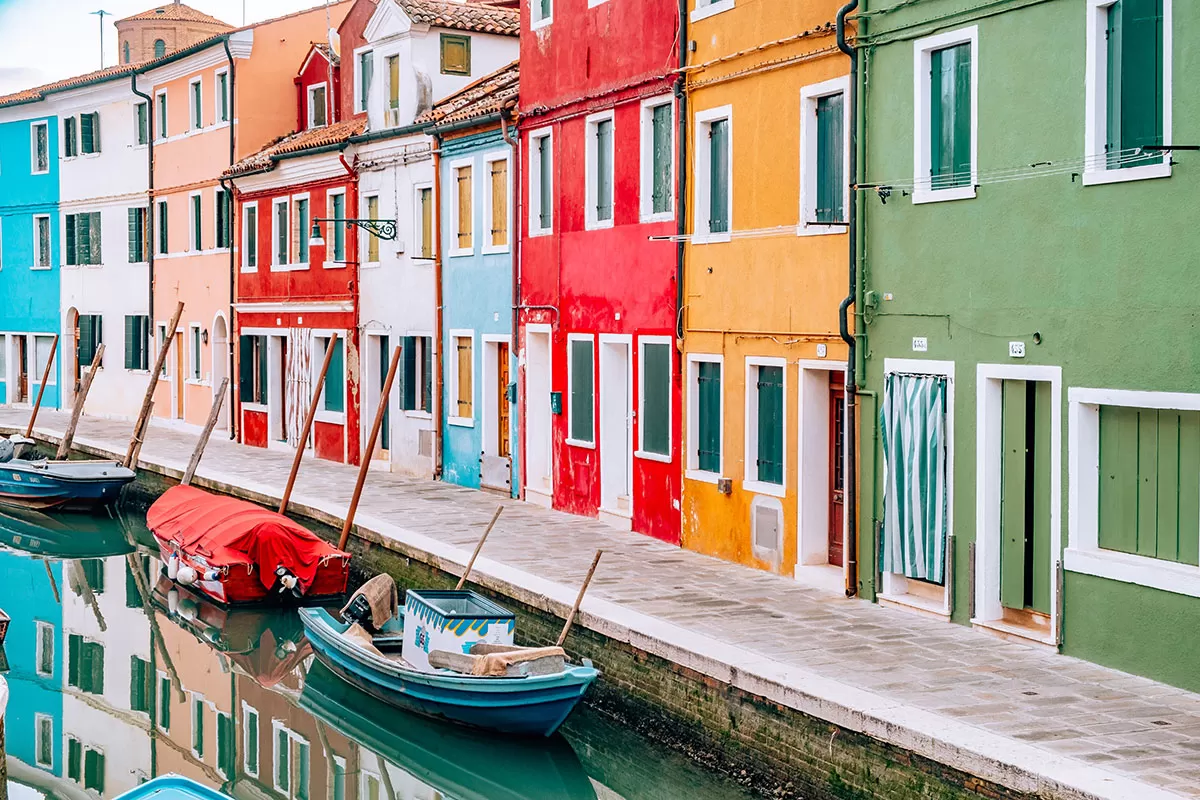 According to my local guide Silvia, she believes it could be due to the fact that Burano sits in a microclimate that receives a cold north wind year-round, also called a bora wind. From the word bora, the name Burano is said to have evolved.
According to my local guide Silvia, she believes it could be due to the fact that Burano sits in a microclimate that receives a cold north wind year-round, also called a bora wind. From the word bora, the name Burano is said to have evolved.
How to get to Burano, Italy
Burano is just 7 kilometres (4 miles) from Venice or a 45-minute trip from St. Mark’s Square by vaporetto, meaning ‘water bus’. Getting to Burano is easy. The quickest way to Burano is by getting the number 12 water bus from the Fondamente Nove in the northern part of Venice. The water bus will also stop in Murano before continuing on to Burano.
When to go to Burano, Italy
Burano is a photographer’s paradise which makes it a hotspot all year round. The busiest time in Burano is during Venice Carnival in February and during the warmer summer months. The majority of visitors are day-trippers from Venice and arrive on the island from 10:30 am and leave just after lunch. Having said that, visitors arrive around the clock with every scheduled water bus with most leaving just before sunset.
Burano is a tiny island, so with a constant influx of visitors, it gets pretty cramped rather quickly. I stayed in Burano for 5 days and preferred to explore early morning and late afternoon to avoid the crowds. While I recommend you stay at least one night if you can only visit for the day, aim to arrive well before 10:30 am so you can absorb some calm island vibes.
Here are the best things to do in Burano Italy as recommended by a local guide.
1. Wander around and explore the charming colourful houses
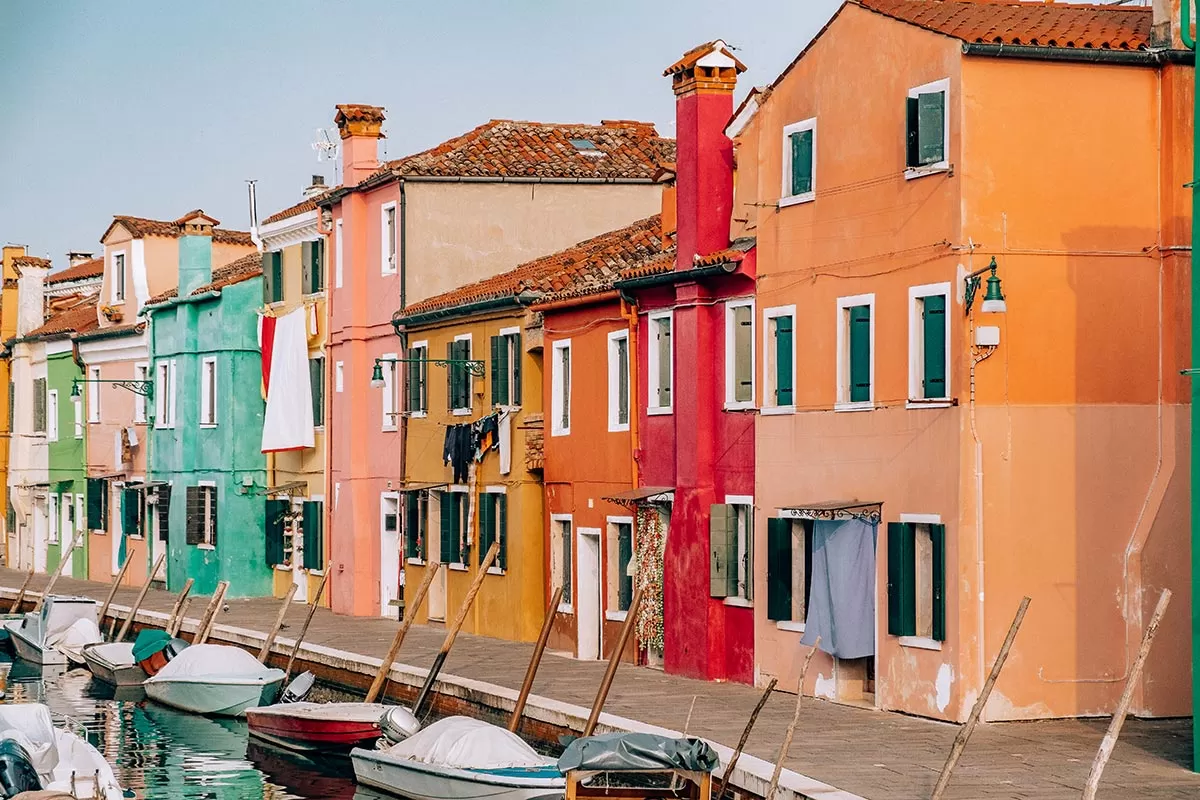 Long before the Venetian Republic was established, Burano was home to fishermen. As the legend goes, the houses were painted in bright colours so they could be seen when fishermen returned home. However, this is just a myth and not the real reason.
Long before the Venetian Republic was established, Burano was home to fishermen. As the legend goes, the houses were painted in bright colours so they could be seen when fishermen returned home. However, this is just a myth and not the real reason.
In fact, the buildings were painted using more natural or muted colours, not the vibrant ones you see today. The reason for painting them in different colours is more practical than you might think. Since each house is quite small, and families consisted of up to 12 children, they would treat the area immediately outside and around their home as an extra room. They would keep things outside, wash items and even set up a table to eat during the warmer months to eat meals. Things that locals still do today! Having a unique colour for each house was important because it set the boundary as to what was your area and that of your neighbour.
At one time you had to ask permission before painting your house, in which case you were allotted certain colours you could use. This is no longer the case, and you can choose any colour you like, as long as it’s not identical to your neighbour’s, for the reasons I mentioned earlier.
Just like clothes, colours here go in and out of fashion, in fact, during the 90s hot pink was all the rage which is why many houses have painted this colour.
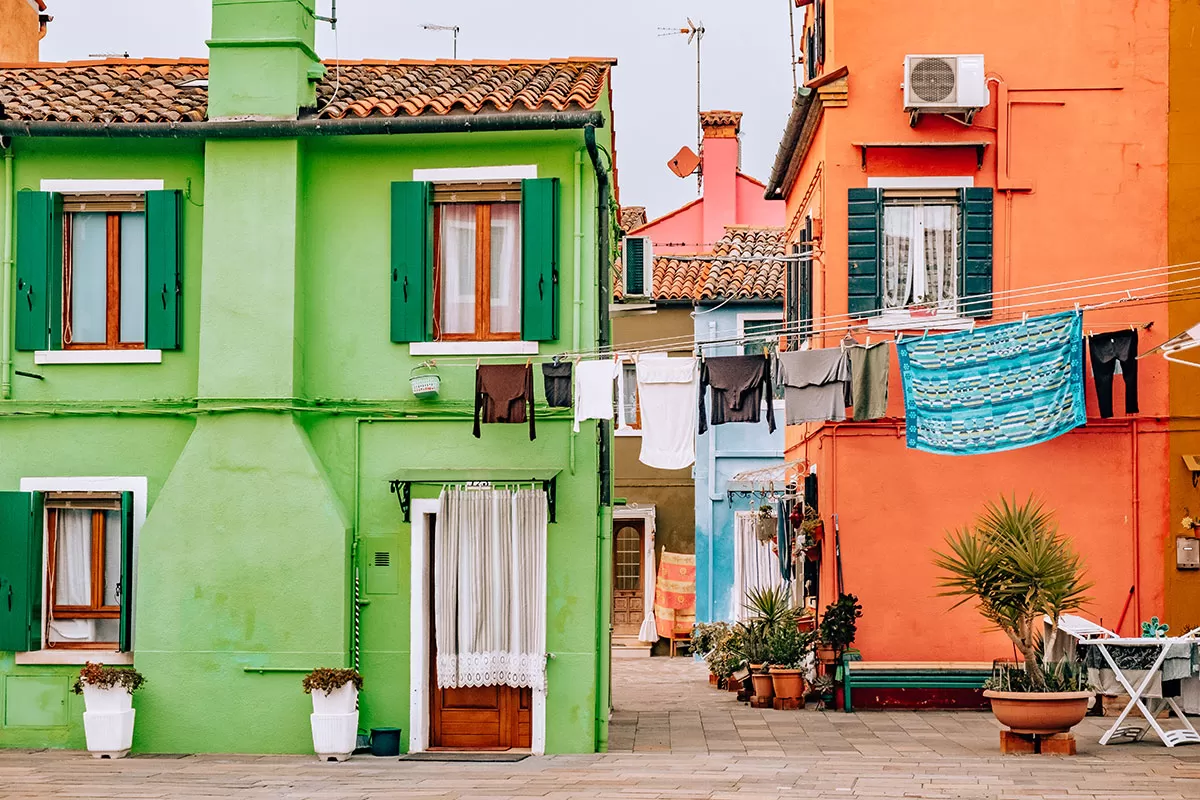
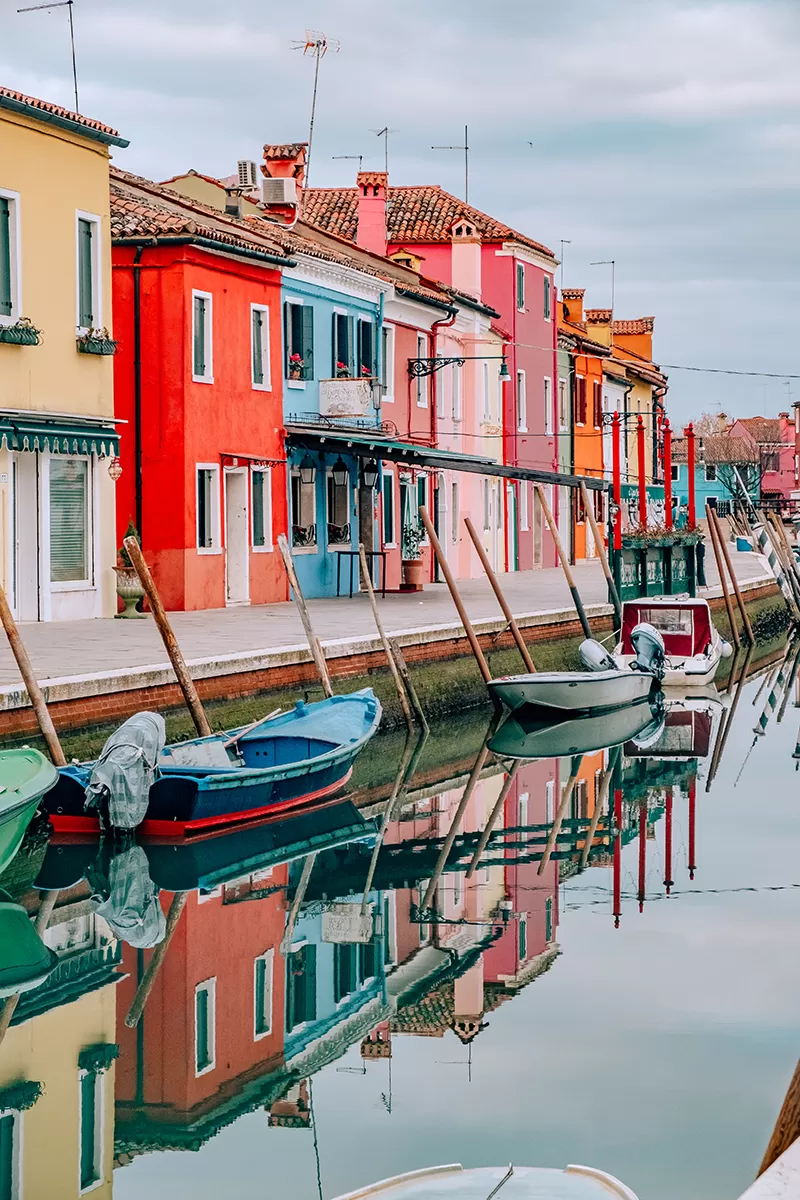
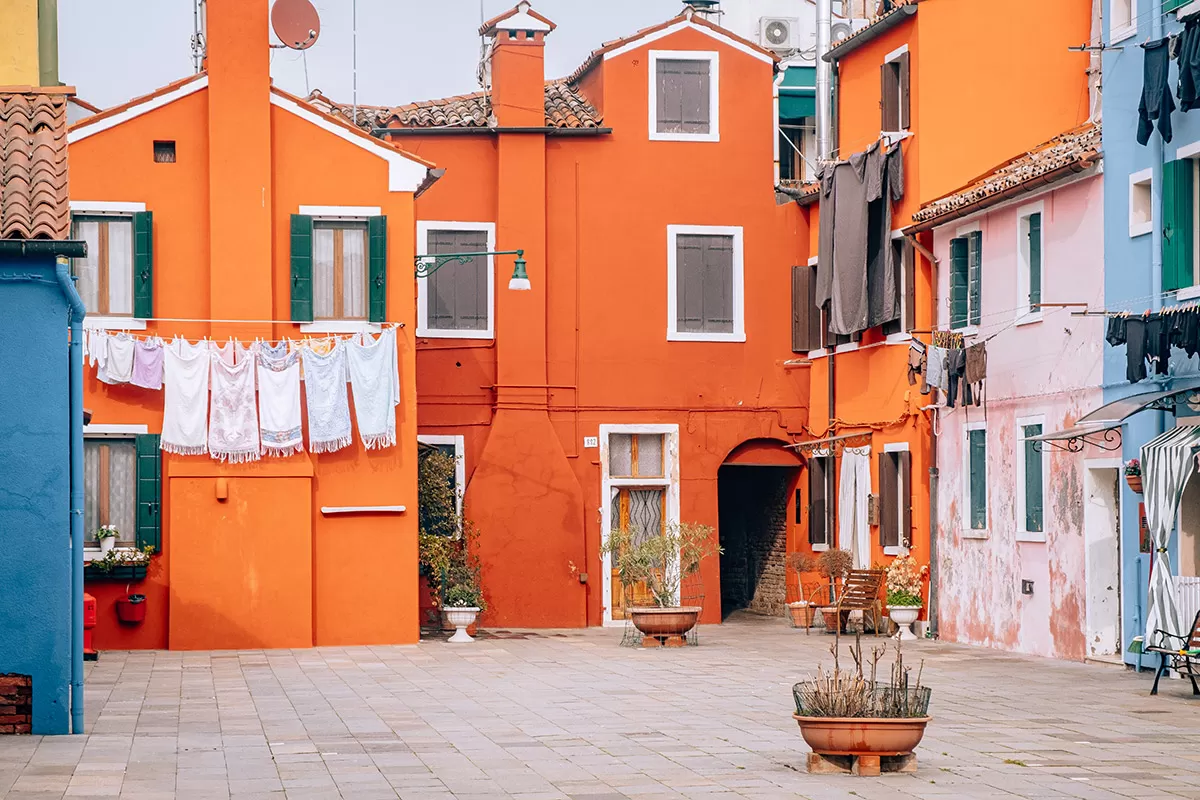
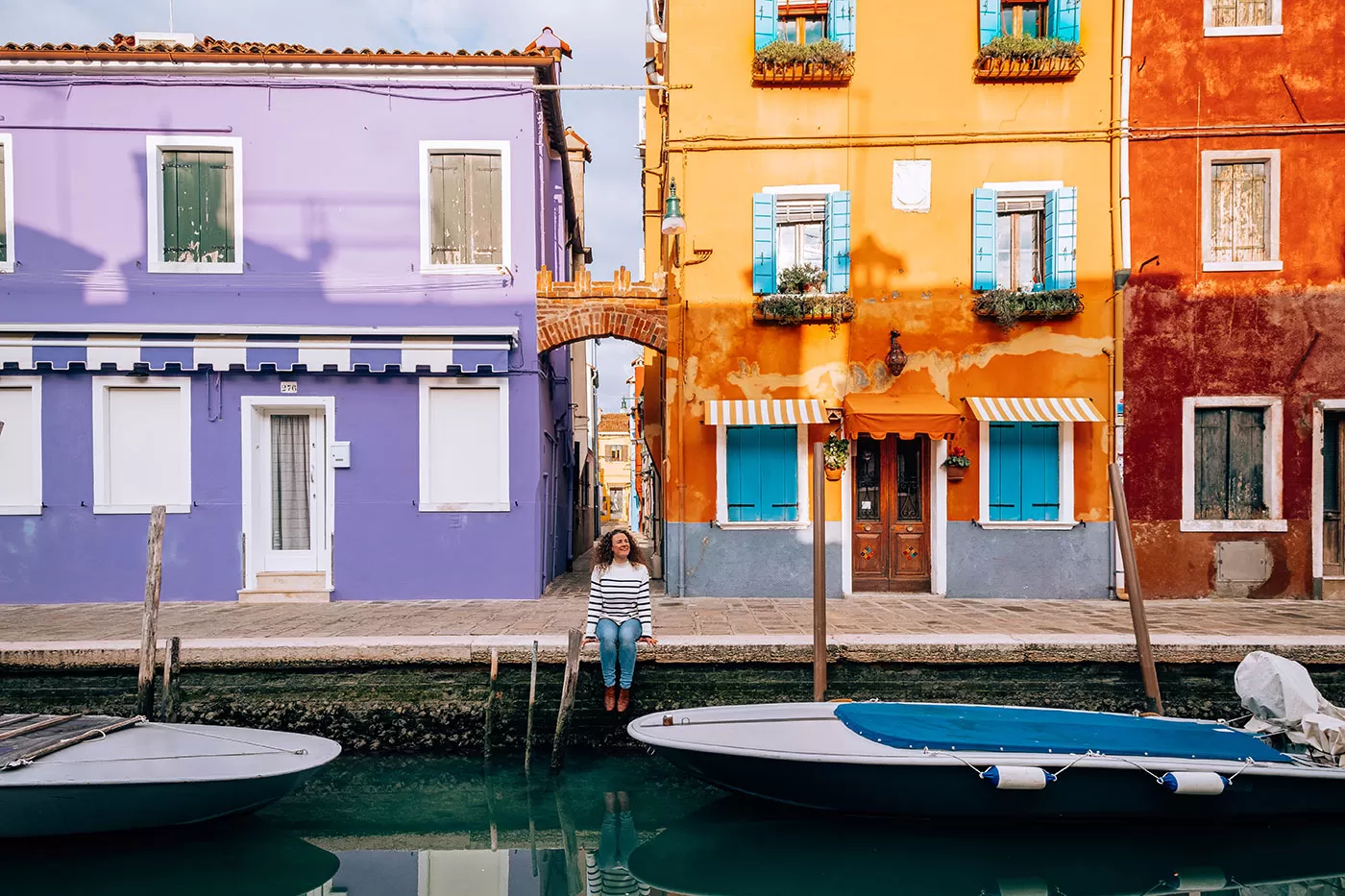
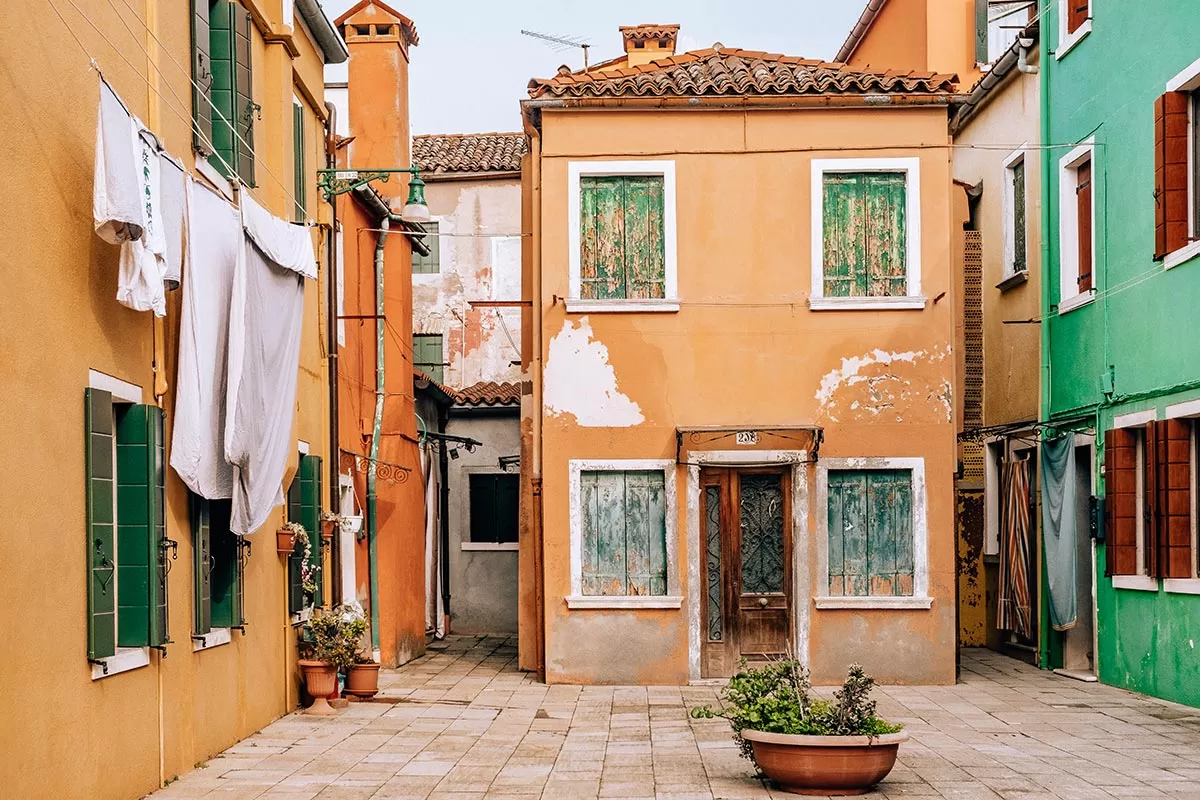
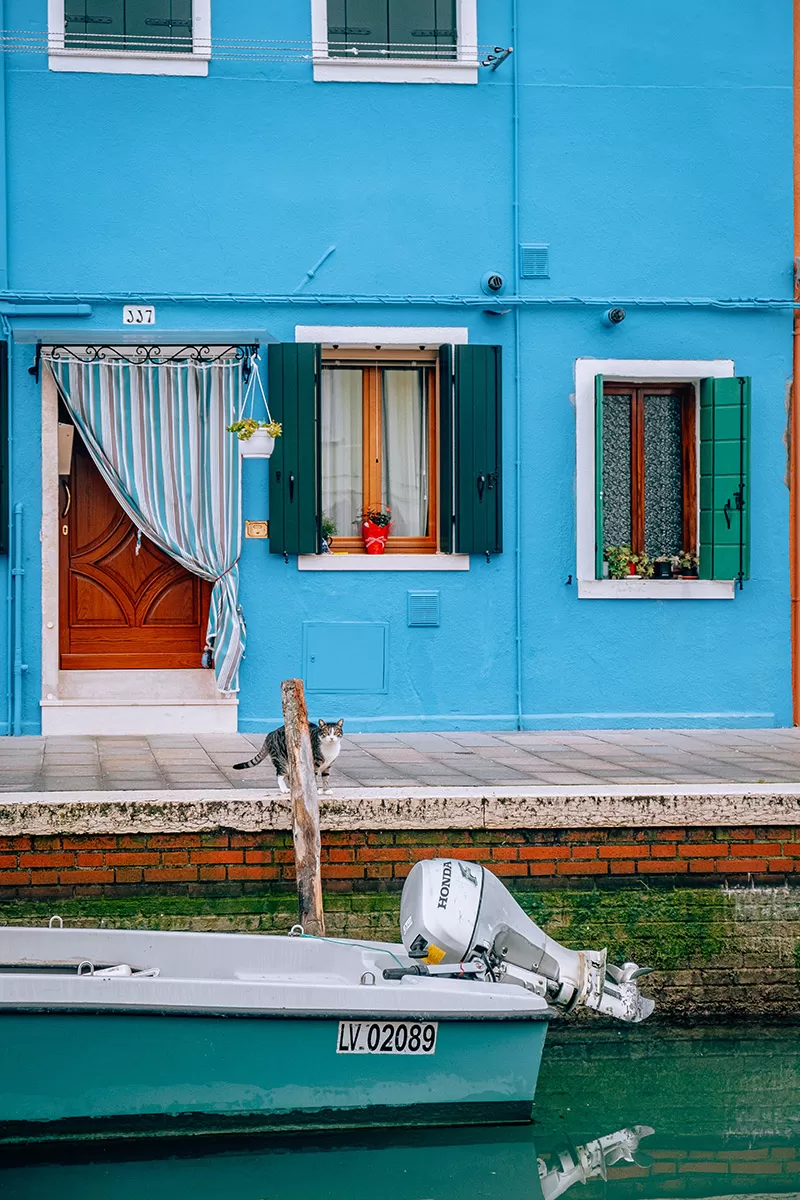
2. See the iconic leaning bell tower at Chiesa di San Martino Vescovo
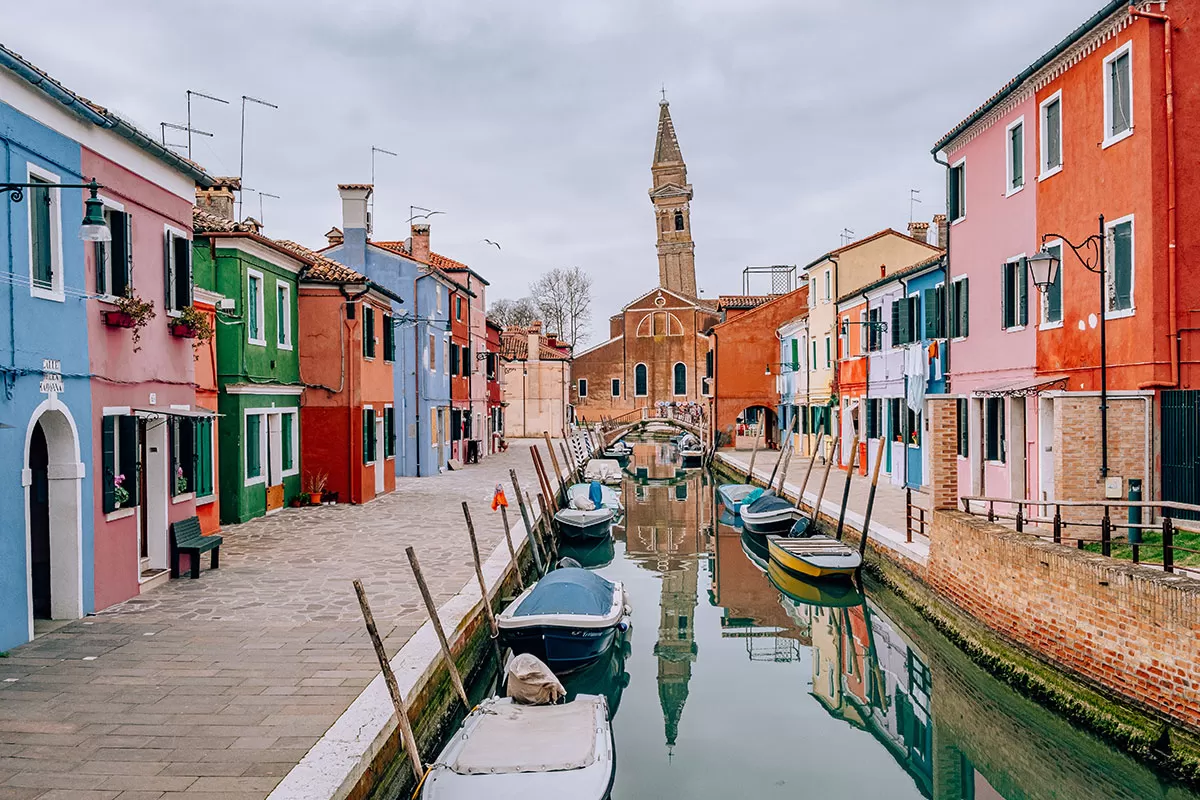
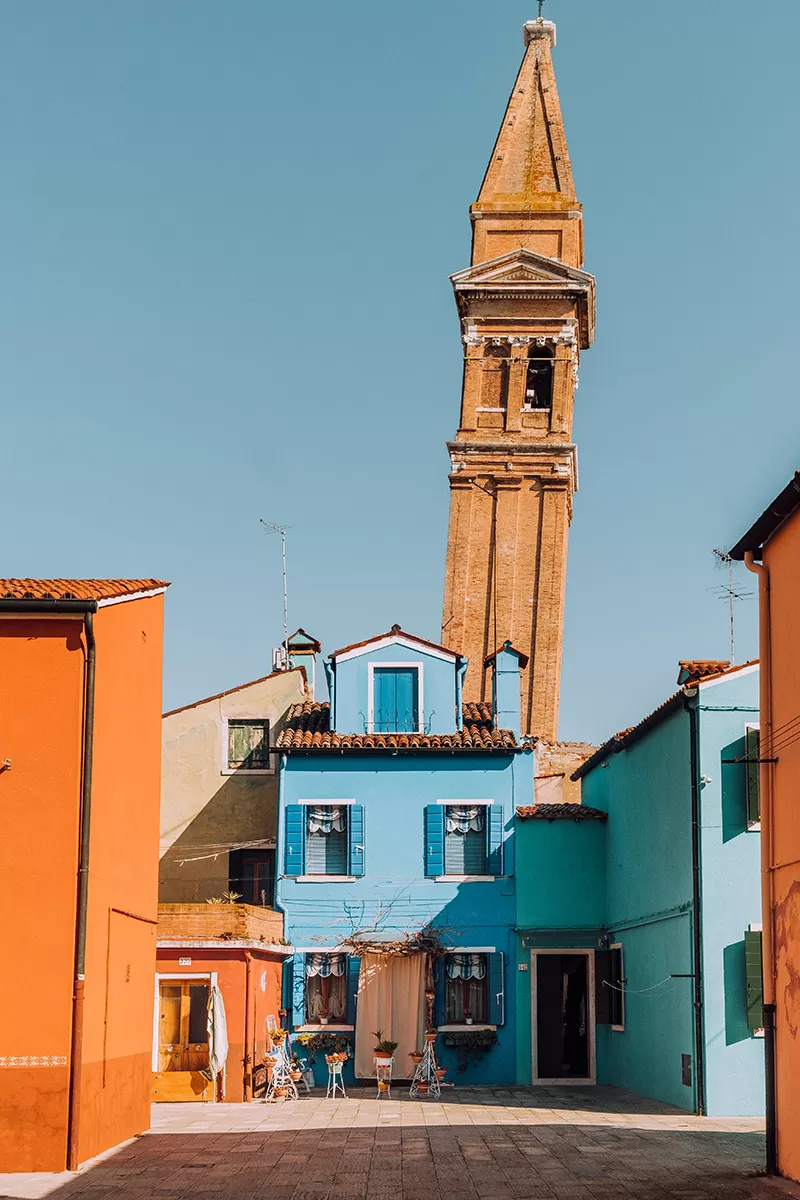
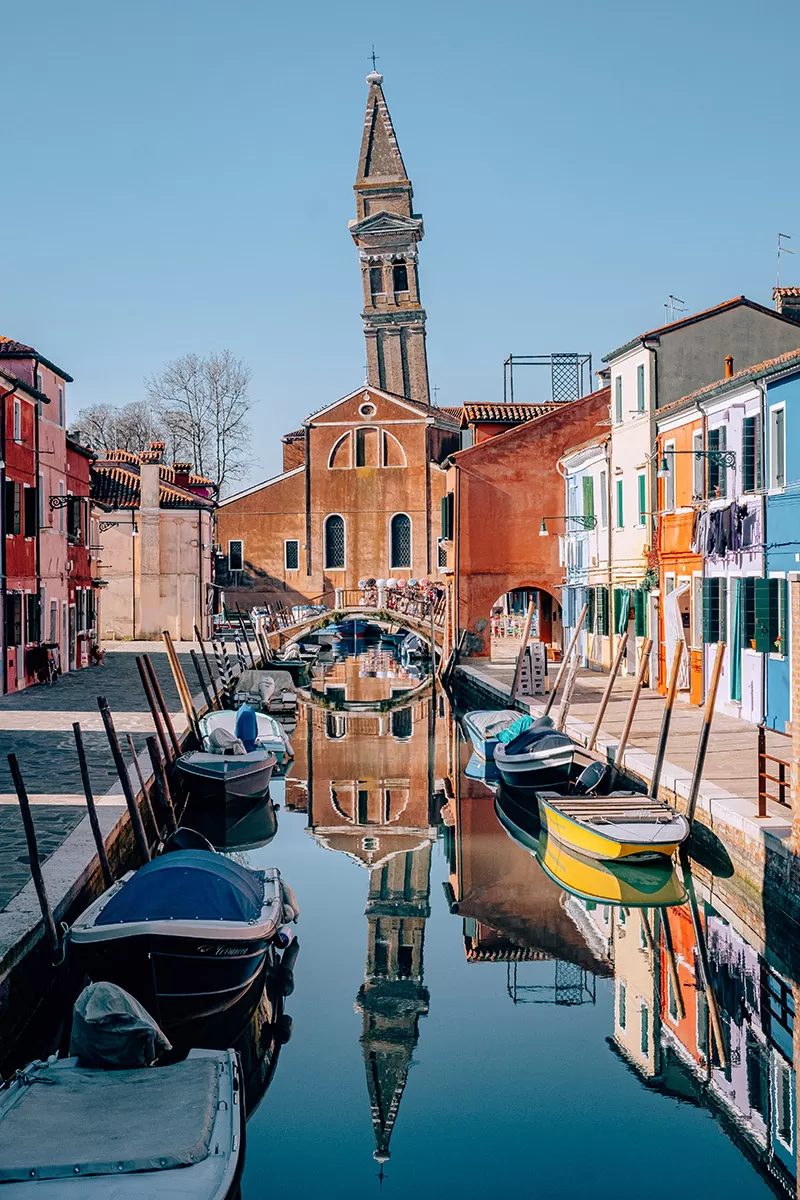 Chiesa di San Martino Vescovo is a 16th-century, Roman Catholic church with an infamous leaning bell tower which has become a symbol of the island. In 1750, a fire destroyed part of the church that was later rebuilt, however, the bell tower was considered too small. So, the uppermost part was cut off and a higher one was added, standing 10m taller than the original one. After a while though, the bell tower began to lean under the new weight of the tower that it wasn’t designed to support.
Chiesa di San Martino Vescovo is a 16th-century, Roman Catholic church with an infamous leaning bell tower which has become a symbol of the island. In 1750, a fire destroyed part of the church that was later rebuilt, however, the bell tower was considered too small. So, the uppermost part was cut off and a higher one was added, standing 10m taller than the original one. After a while though, the bell tower began to lean under the new weight of the tower that it wasn’t designed to support.
In fact, one night in 1961, the bell sounded all of sudden, confusing residents. This was the first sign that the tower was unstable. Thanks to expert engineers from Naples, they came here to reinforce the foundations, driving long wooden pools consisting of iron all the way to 23,5m deep through the mud, to reach the sand to create the required support.
The top of the leaning tower had always been crowned by an angel, but during a storm in 1867 this fell off. Today, in its place is an iron cross.
- Opening hours: Mon-Sun 8.00-12.00; 15.00-18.00
- Address: P.za Baldassarre Galuppi, 20, 30142 Venezia VE, Italy
3. Eat some ‘buranelli biscotti’ from Pasticceria Costantini
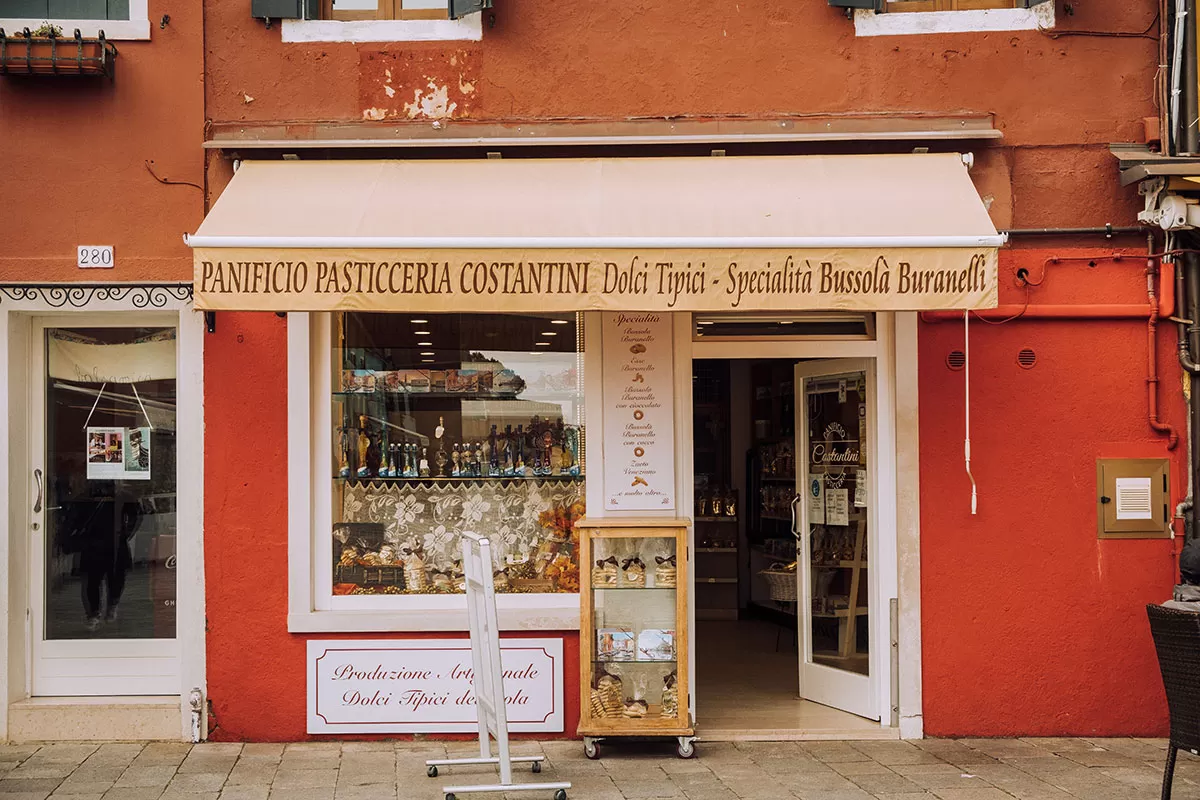 Bussolai or esse buranelli are typical biscuits from Burano and are an absolute must when you visit. Originally, these biscuits were circular in shape like a compass but over time the shape has changed to S which they say represents the shapes of the Grand Canal. Today you canal find both types: the classic Bussolà (meaning Compass) or the Esse (meaning the letter S)
Bussolai or esse buranelli are typical biscuits from Burano and are an absolute must when you visit. Originally, these biscuits were circular in shape like a compass but over time the shape has changed to S which they say represents the shapes of the Grand Canal. Today you canal find both types: the classic Bussolà (meaning Compass) or the Esse (meaning the letter S)
These dry biscuits were prepared by the wives of fishermen to take with them as they kept for a long time and are very caloric. In the past, this was important for fishermen who spent long periods at sea.
Other than the shape, the recipe has remained almost unchanged and is typically found leading up to Easter. The recipe contains a shortcrust pastry with butter, egg yolks, a single whole egg, lots of butter and sugar, and lemon peel.
The original and the best bakery/patisserie who have been making the traditional recipe for over 100 years, is the Pasticceria Costantini.
- Opening hours: Mon-Sun 7.30 am -7 pm
- Address: Via San Martino Sinistro, 282, 30142 Burano VE, Italy
- Visit the Pasticceria Costantini website
4. Learn about Burano lace at the Lace Museum (Museo del Merletto)
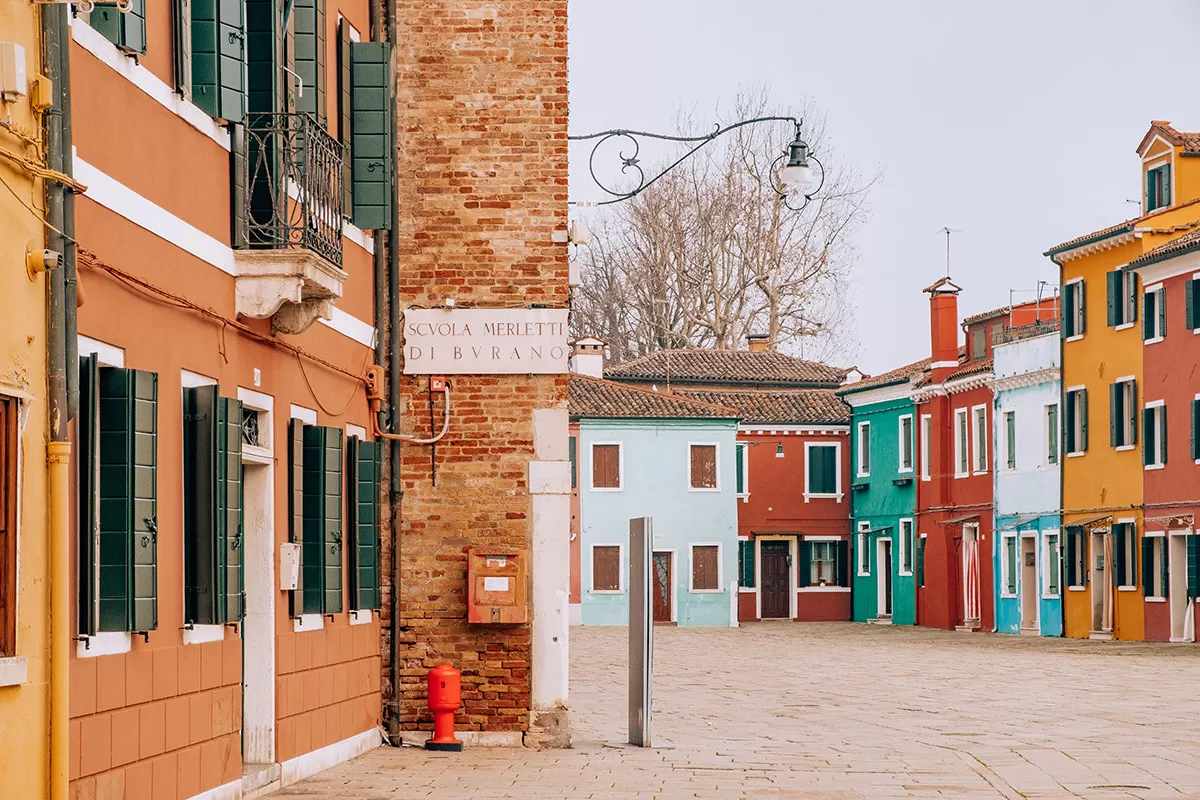 As with most things in Burano, there is a legend behind everything and the most famous is the story of how lacemaking came to the island. As the legend goes, a poor fisherman was in love with a local girl but didn’t have enough funds to his name to ask her hand in marriage. Then during a sea trip to the east, he heard the song of a siren. But, unlike other fishermen before him, he resisted her charms because of his love for another woman. In return, for his loyalty, the queen, who was fascinated by his loyalty, slapped the side of his boat with her tail and from the foam, created by the movement of the water, formed a marine flower. With this, the fisherman took the precious flower to the father of his beloved to ask for her hand in marriage. The father agreed. Before the flower began to wilt, the design was recreated as a lace wedding veil for the young bride.
As with most things in Burano, there is a legend behind everything and the most famous is the story of how lacemaking came to the island. As the legend goes, a poor fisherman was in love with a local girl but didn’t have enough funds to his name to ask her hand in marriage. Then during a sea trip to the east, he heard the song of a siren. But, unlike other fishermen before him, he resisted her charms because of his love for another woman. In return, for his loyalty, the queen, who was fascinated by his loyalty, slapped the side of his boat with her tail and from the foam, created by the movement of the water, formed a marine flower. With this, the fisherman took the precious flower to the father of his beloved to ask for her hand in marriage. The father agreed. Before the flower began to wilt, the design was recreated as a lace wedding veil for the young bride.
The bride was admired and envied by all the young girls on the island and they began to imitate the lace of her veil using even thinner needles and thread, hoping to create an embroidery even more beautiful for their wedding dress.
While this legend is very romantic, it was in the 16th century that women of Burano were introduced to making lace with needles thanks to the Venetian-ruled island of Cyprus. It was from then on that Burano rose to fame for its delicate and laboriously created lace with its lace being exported throughout Europe.
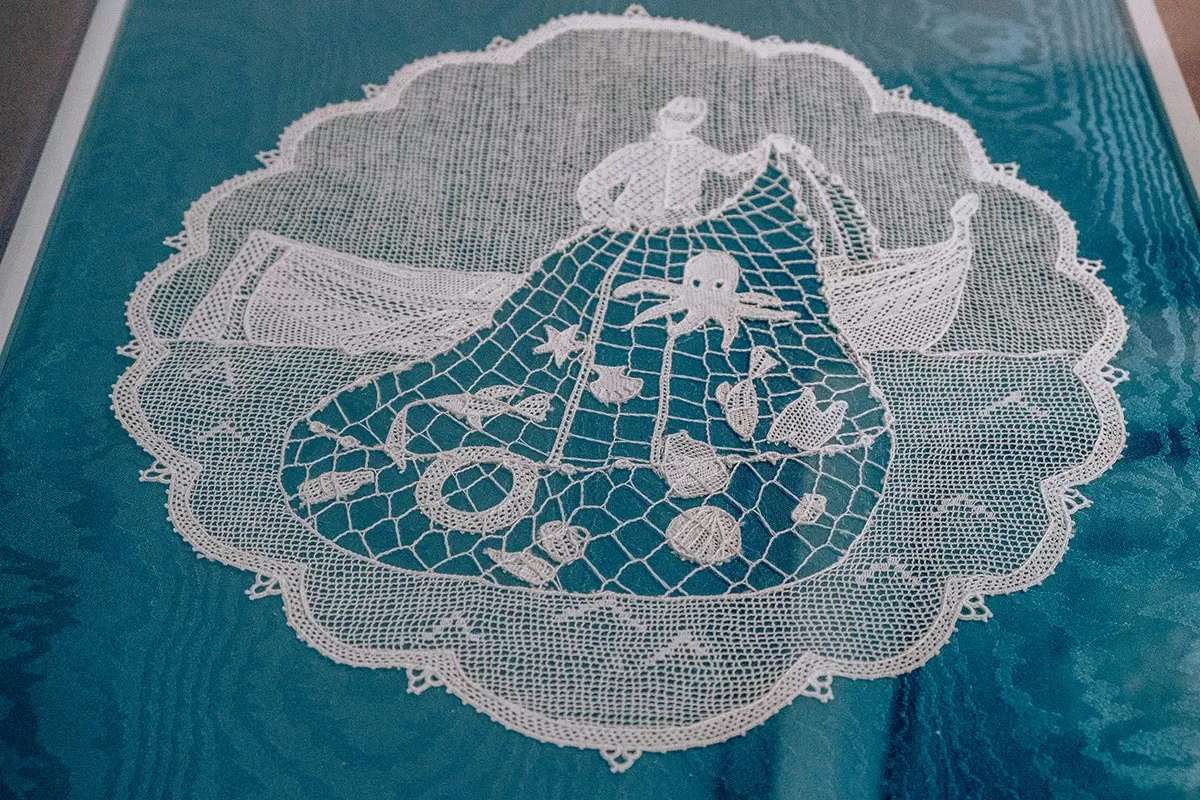
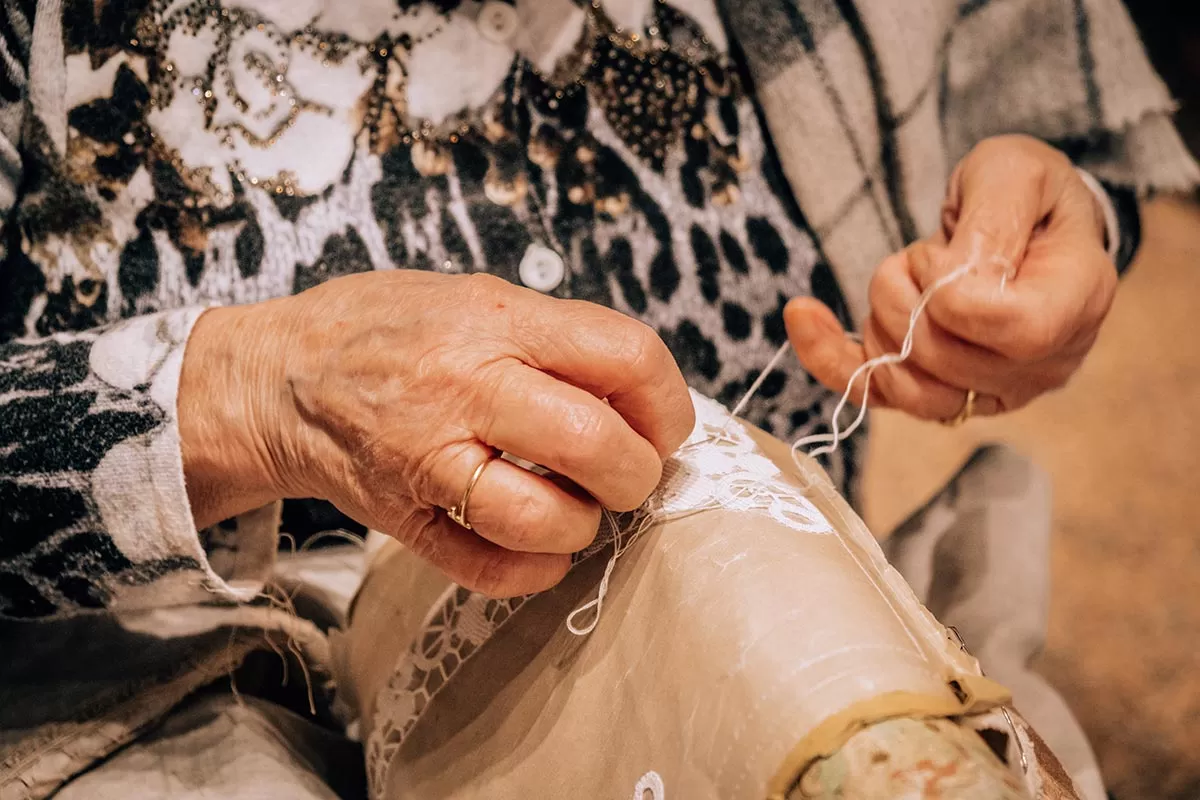 In the 16th century, Venetian needle lace-making was an elevated art form. Many girls started learning as young as 8 years old, then after 6 years of training, they were trained enough to be hired. This was the first job the women of Burano were paid for, bringing in a monthly salary. They even outearned their partners.
In the 16th century, Venetian needle lace-making was an elevated art form. Many girls started learning as young as 8 years old, then after 6 years of training, they were trained enough to be hired. This was the first job the women of Burano were paid for, bringing in a monthly salary. They even outearned their partners.
After roughly 20 years, you could be a teacher. What’s interesting is that with all the time it took to learn the techniques of lace making, many women couldn’t read or write.
In the 17th century, bobbin lace was professionalised in other parts of Italy, despite this, European countries struggled to compete with the women of Burano’s skill and signature designs. Their needlework was recognised in the banquet halls and courts all across the continent.
In fact, the court of King Louis 14th in France employed several Venetian lacemakers to teach their skill and facilitate home manufacturing.
Lace-making is very time-intensive and thus a highly lucrative craft. Due to its high price, Burano lace fell out of demand over the following centuries when it has to compete with cheaper alternatives and fashion trends. Because of this, the skill of lace-making was almost entirely lost.
Lace production in Burano survives today as a cherished, traditional art form and creative outlet rather than as a thriving commercial trade product. Tourism is its main market.
Handmade items are still created exclusively by the island’s female residents who learn the craft at as young as 10 years old. If you spend enough time in Burano you will spot them seated in a shop front or doorway in complete flow of their ancient craft.
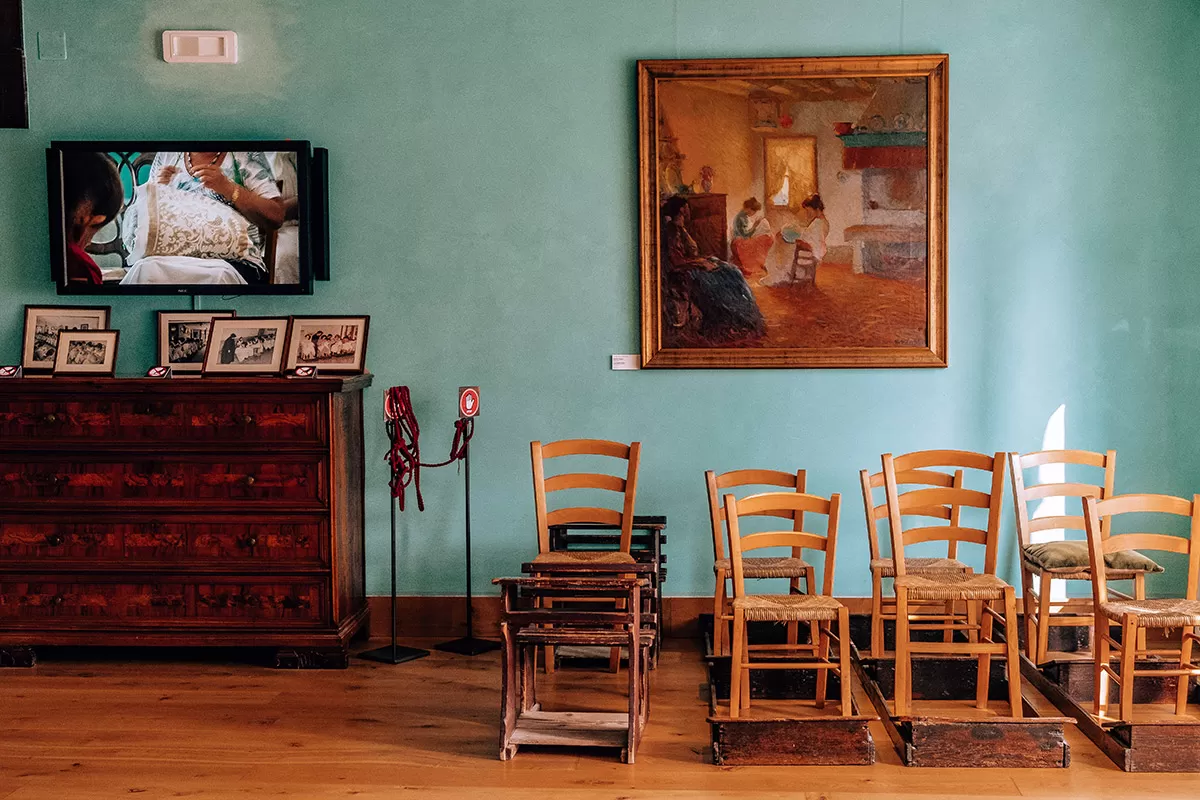
The women of Burano continue making lacing thanks to their desire to preserve their local heritage. Many of them were taught either by their mothers and grandmothers or by attending the prestigious lace-making school ‘Scuola di Merletti’ which was established in 1872 and closed in 1970. Today, a few still make lace in the traditional manner as it is extremely time-consuming and therefore expensive
This is now the home of the Museo del Merletto (Lace Museum) which follows the history of the trade. On display are Pattern books, journals, paintings, furniture, costumes and an extensive collection of samples.
In one of the rooms, a group of local lacemakers often sit tatting and gossiping beneath pictures of the Lace School, where many of them learned their craft. If you see them, feel free to ask them questions as they go about their work.
- Opening times: Tuesday – Sunday 10 am – 4 pm
- Address: P.za Baldassarre Galuppi, 187, 30142 Venezia VE, Italy
- Visit the Lace Museum website
5. Wander the lace stores and visit Dalla Lidia
After visiting the Lace Museo, I highly recommend you visit dalla Lidia. This is a lace shop with a two-level gallery with an extensive display of antique lace. Here you’ll find many more exquisite lace examples compared to the Lace Museum and you’ll also be able to buy authentic Murano lace made by an elderly lady who creates lace here most days. You can see me here any time between 10 am and 6 pm.
- Opening hours: Mon-Sun – 9:30 am – 6:30 pm
- Address: Via Baldassarre Galuppi, 215, 30142 Venezia VE, Italy
- Visit the Dalla Lidia Merletti D’Arte website
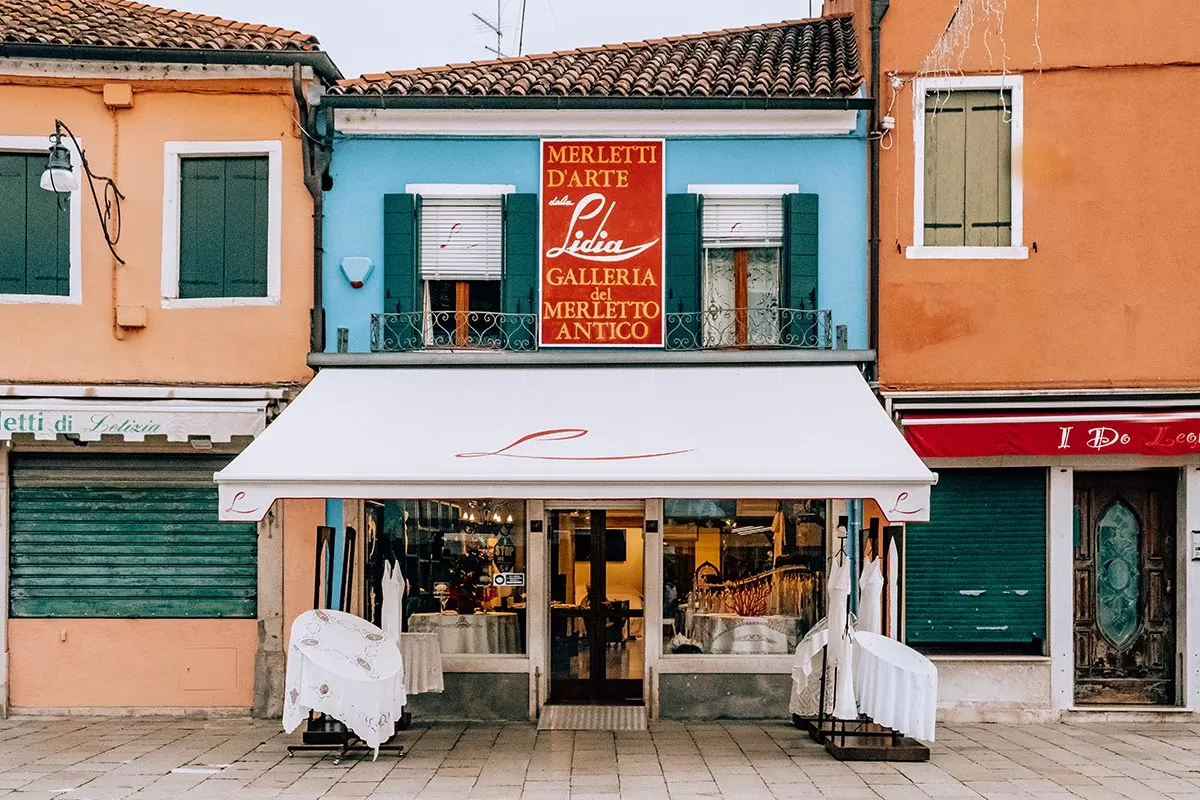
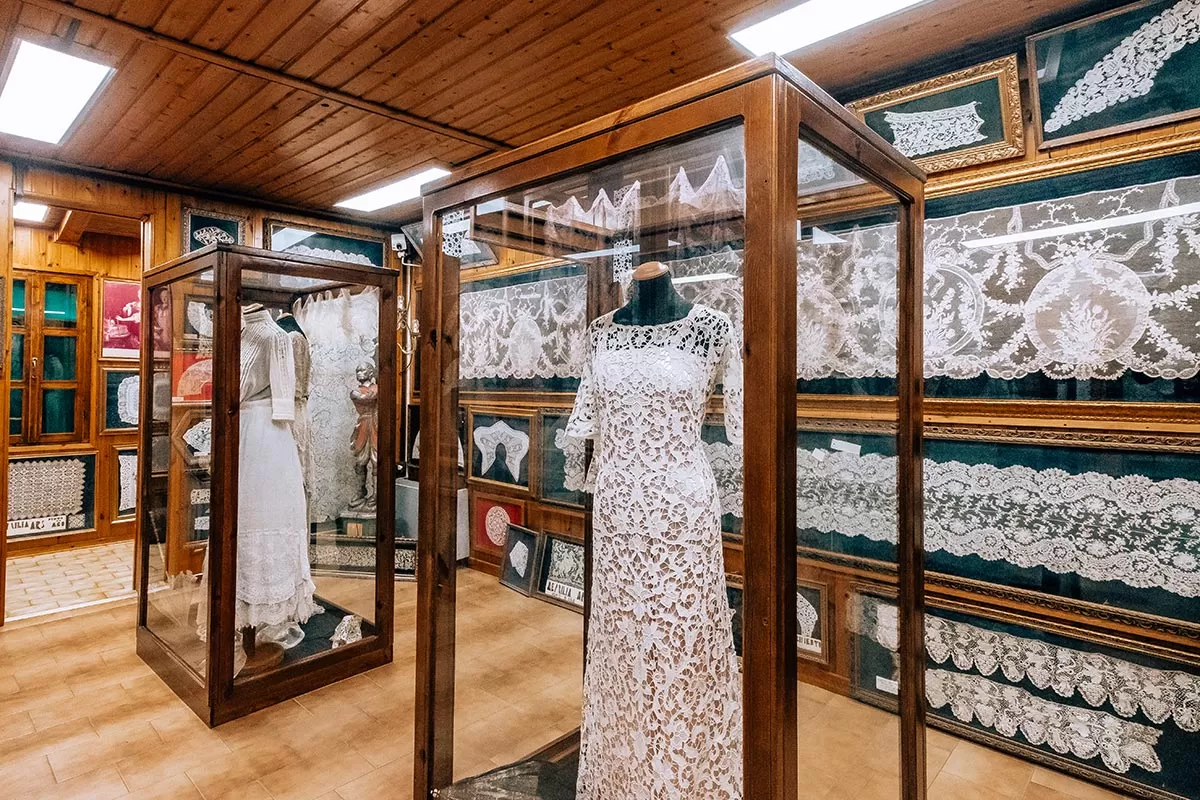
6. Look out for the characteristic window stoppers
This interesting curiosity was shared with me by local guide Silvia. As you wander around Burano, take note of how the window shutters are held open. What you’ll see is quite unique and representative of the island. On traditional windows, you’ll see that the shutters are held open by a black bracket. When the shutters are being held open, the stopper on the end of the bracket shows a face of a man, said to be the man/owner of the house. When the shutters are released, the stopper reveals a woman’s face, representing the lady of the house. These traditional stoppers are no longer produced, so you will only see them on older houses.
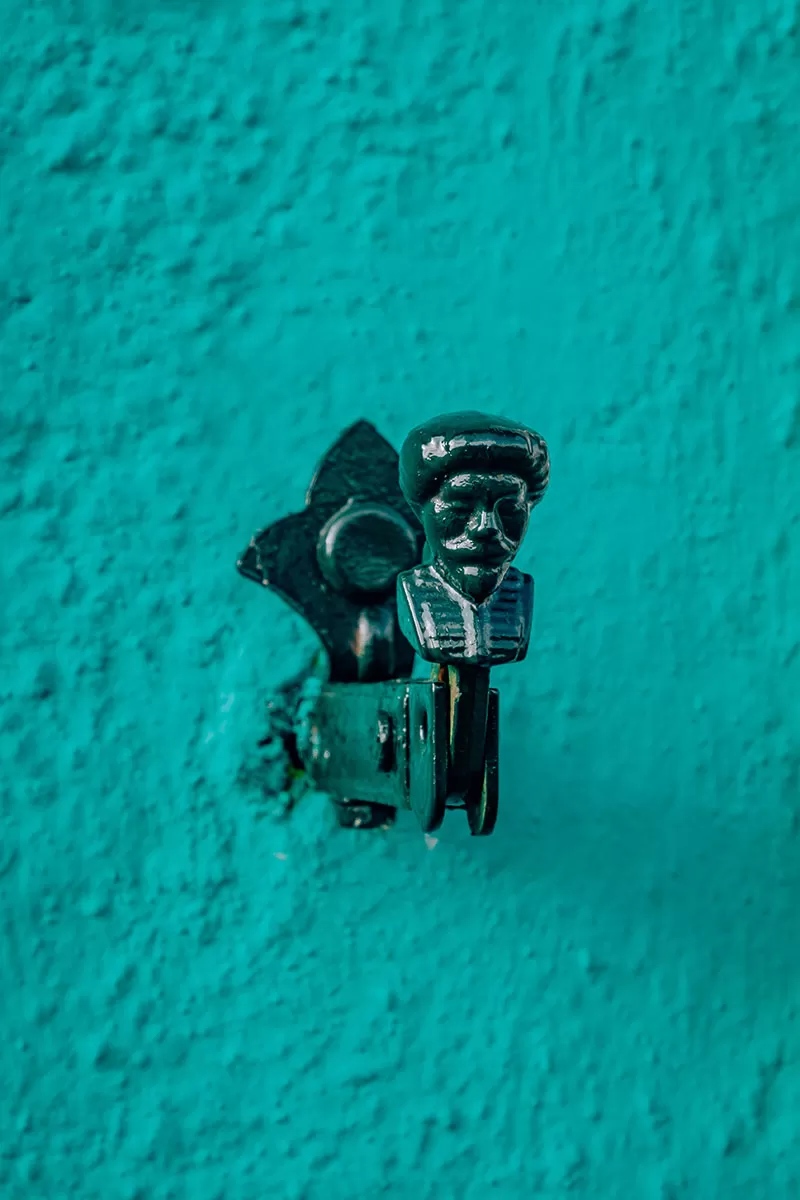

7. Visit Piazza Baldassarre Galuppi
Baldassare Galuppi (Born Burano 1706 – Died Venice 1785), nicknamed “Il Buranello”, was of the most important Italian composers of his time, famous for his operas especially his opera buffa (a type of opera originating from Naples in the 18th-century). His interest in music developed thanks to his father, a skilled barber, who played the violin as a hobby.
In 1748 Baldassare Galuppi became maestro di cappella at San Mark’s Cathedral, considered the Venetian top musical post. For the majority of his life, Galuppi lived and worked in Venice and spent a few years in London, working for the Royal Theatre and in St. Petersburg where he worked for Catherine II the Great. Galuppi then returned to Venice in 1768 and continued to compose for the theatre and the Church.
To express their gratitude to this great composer, the island of Burano named its main square after Baldassare Galuppi and erected a monument in his honour, made by another Buranello, the sculptor Remigio Barbaro.
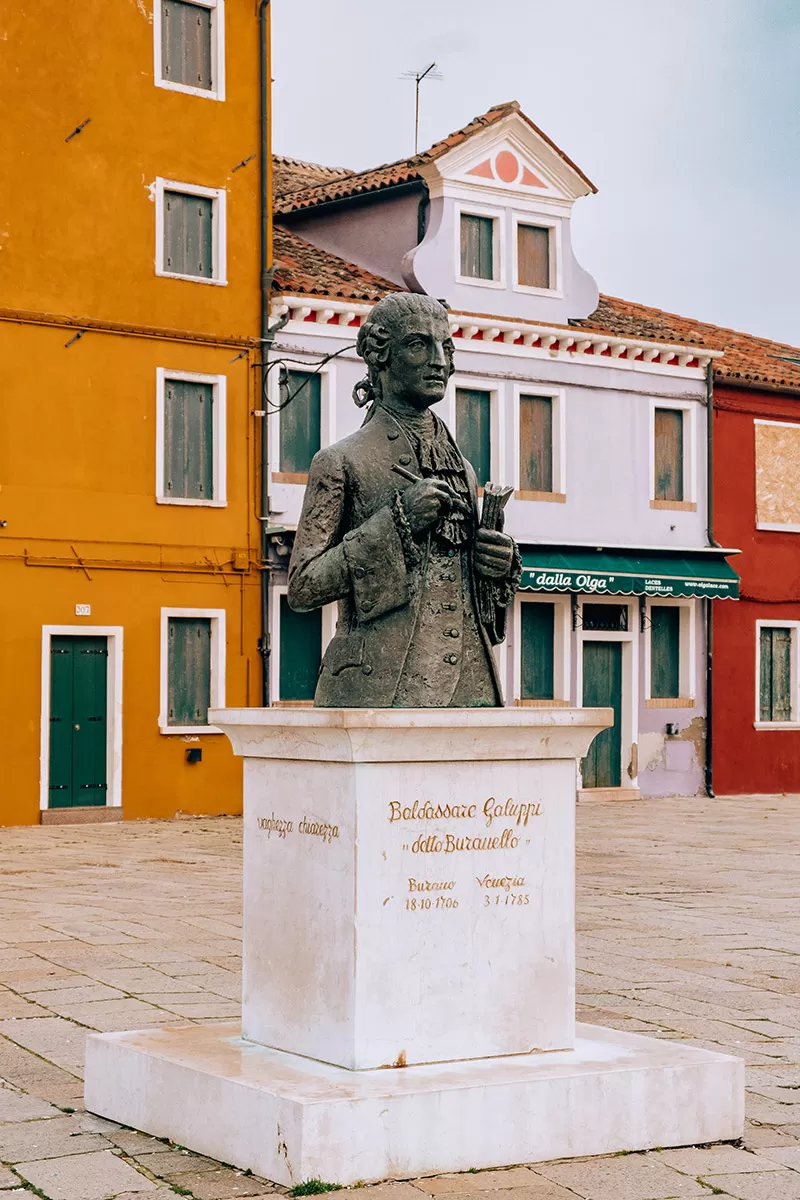
8. Visit Bepi’s colourful house
Of all the houses of Burano, the house of Bepi Suà (also known as “Bepi of Candies”) is the most colourful and famous on the island – decorated with all kinds of geometric shapes. The reason why Bepi painted these shapes and didn’t use a single colour is because he couldn’t afford enough paint. Instead, the locals would donate what they had leftover of their paint which is why so many colours are used.
Bepi, aka Giuseppe Toselli, not only loved to paint, he was also a movie buff. He worked as a janitor at Cinema Favin but when the cinema was closed, he began to sell candies and sweets in Burano’s Galuppi Square which is how he got his name Bepi of Candies.
Until the early 1980s, during the warm summer evenings, he would organize an outdoor cinema in his campiello (a term for a Small Venetian square, into which calli lead). Bepi would hang a white sheet on the wall of his house, and project cartoons and other entertaining films for the children of Burano.
Locals jokingly nicknamed him Bepi Suà (meaning: Sweaty Bepi) because he was a notoriously lazy worker.
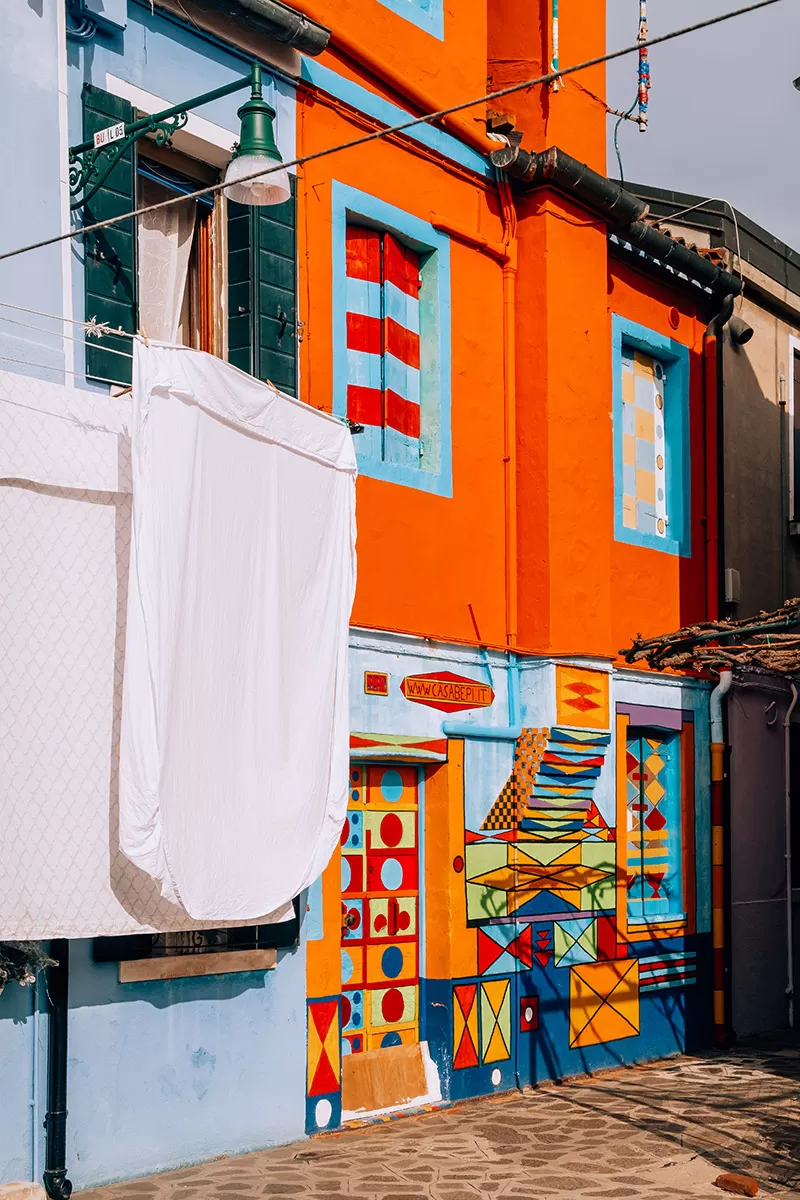
9. See the ‘high tide’ house
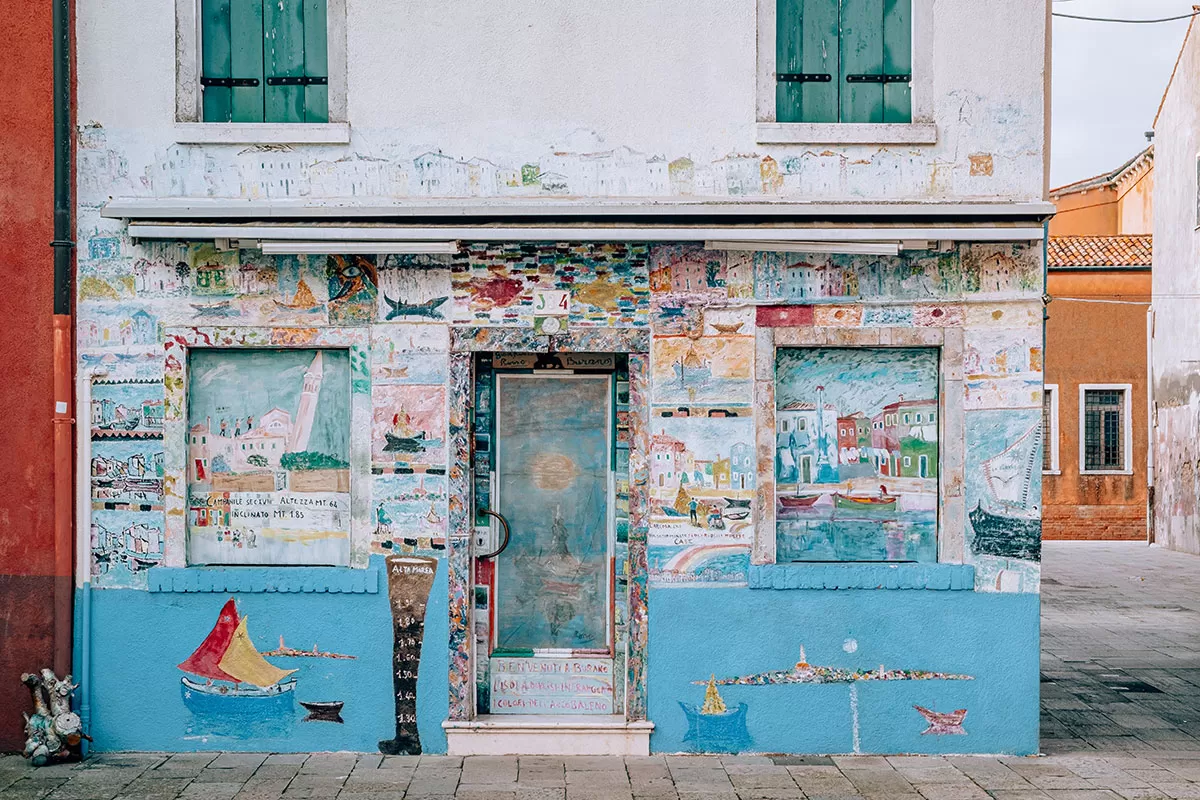
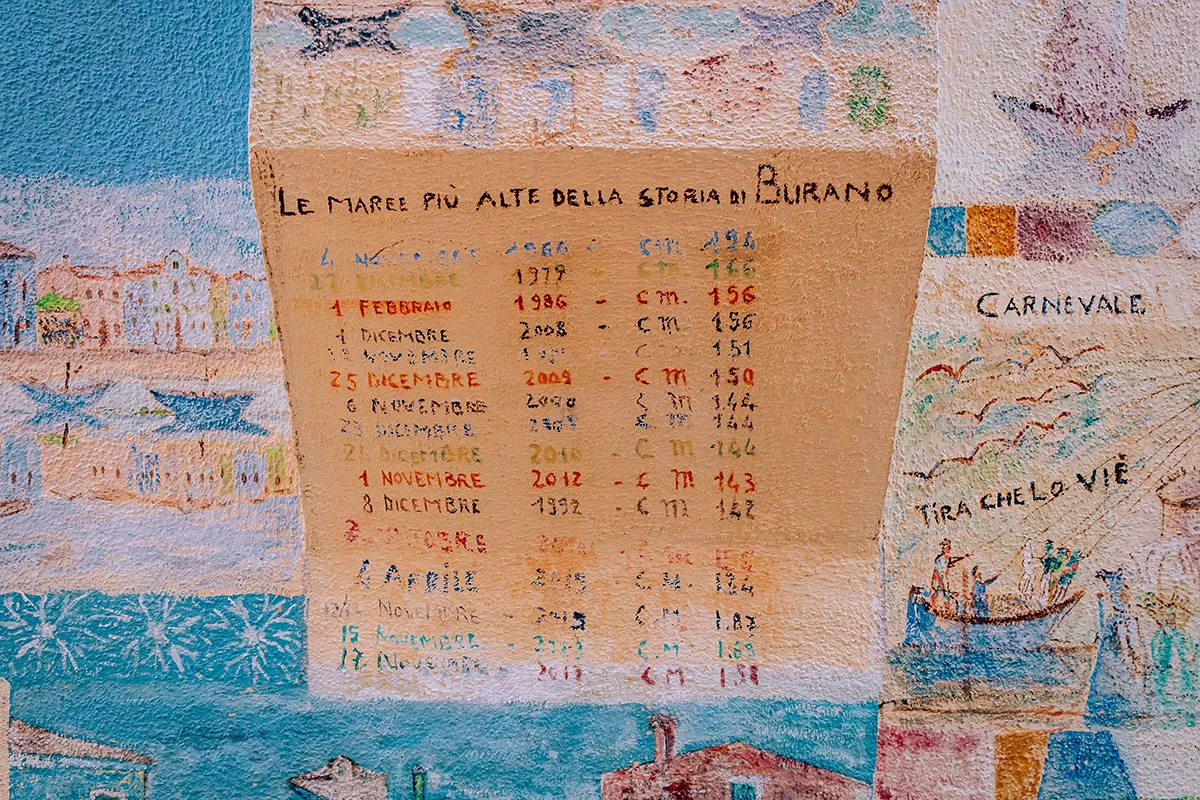 Located just the corner from the Piazza Galuppi is a small house covered in artwork. What makes it special is that on the side of the right side of the building is a list of each of the occasions when high tide (Italian: alta marea) affected the island. It shows the full date and how many centimetres the water level rose by.
Located just the corner from the Piazza Galuppi is a small house covered in artwork. What makes it special is that on the side of the right side of the building is a list of each of the occasions when high tide (Italian: alta marea) affected the island. It shows the full date and how many centimetres the water level rose by.
10. Take a walking tour with a local
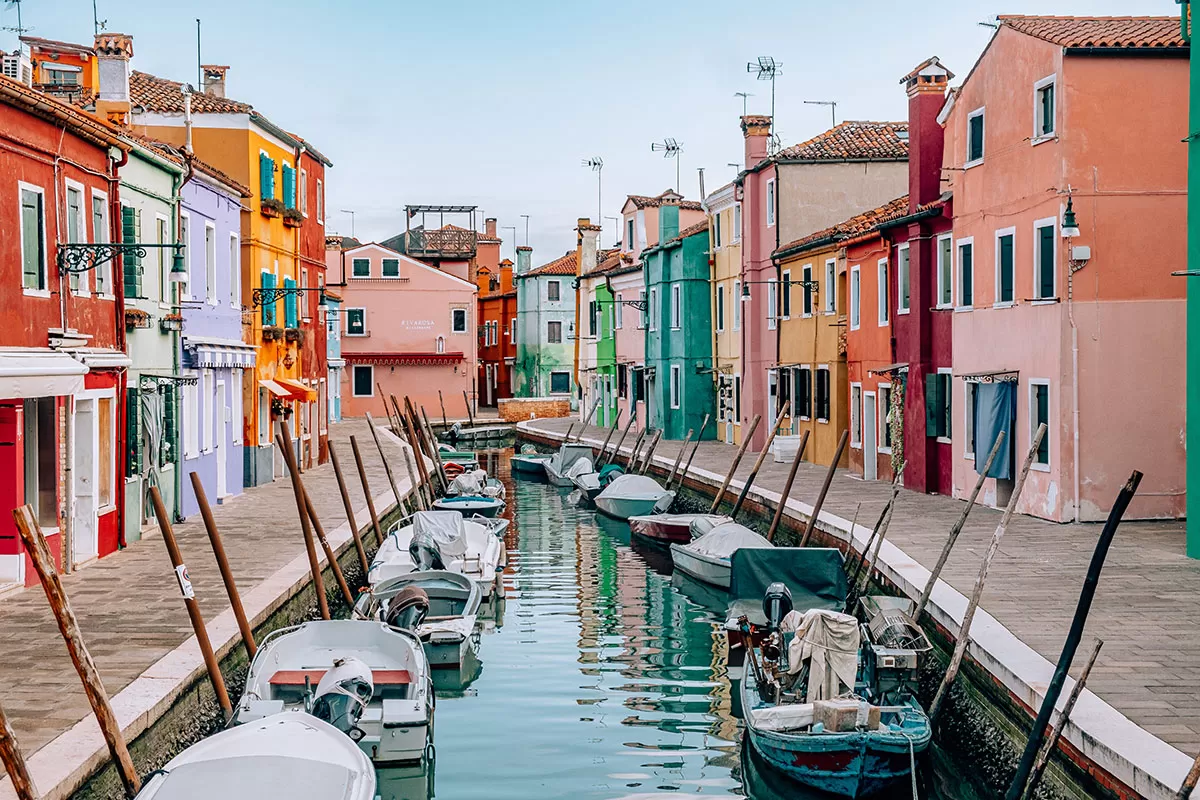 While most people visit Burano for a day trip I think it’s worth staying for at least a couple of nights. Up until 11 am and from sunset, you can really appreciate the beauty of this colourful island and enjoy the calm atmosphere with just the locals. By staying the night, it will also allow you to join a morning walking tour with a local guide who can really bring this island to life, beyond the pretty facades that many people come here for. To join the same walking tour I did, click here to check availability and book.
While most people visit Burano for a day trip I think it’s worth staying for at least a couple of nights. Up until 11 am and from sunset, you can really appreciate the beauty of this colourful island and enjoy the calm atmosphere with just the locals. By staying the night, it will also allow you to join a morning walking tour with a local guide who can really bring this island to life, beyond the pretty facades that many people come here for. To join the same walking tour I did, click here to check availability and book. 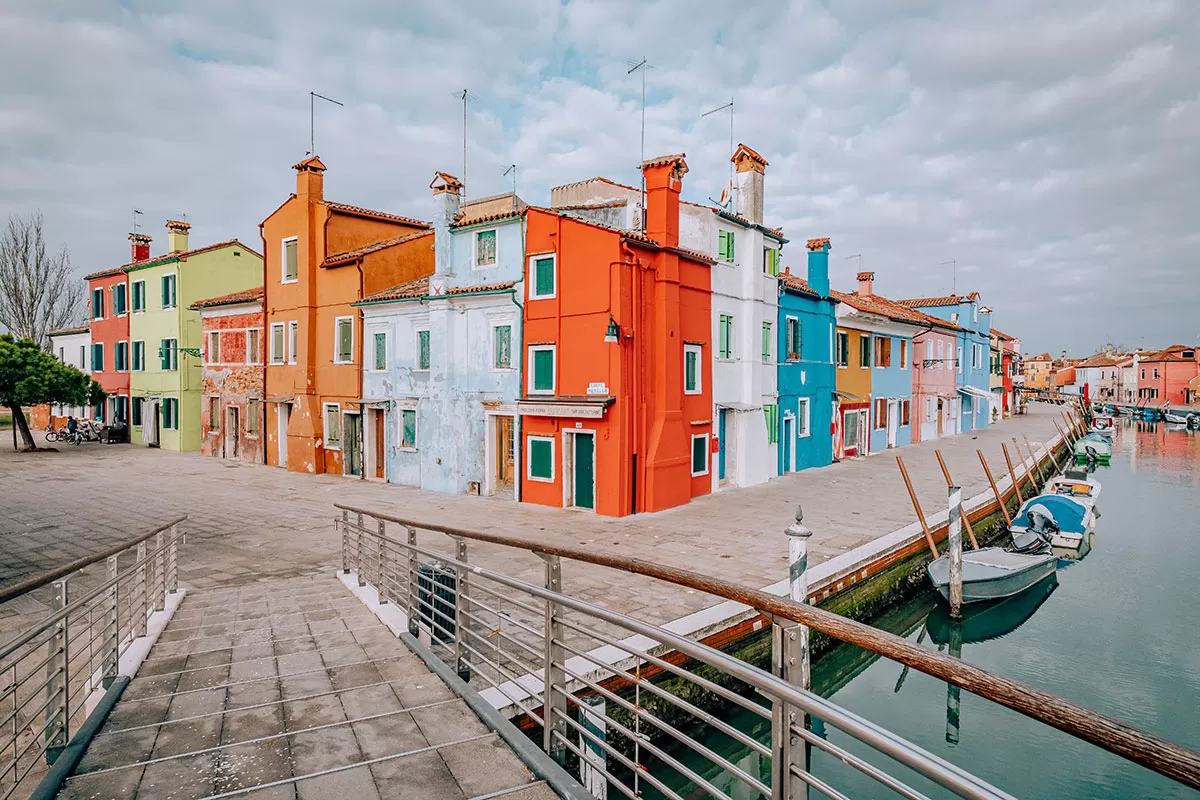
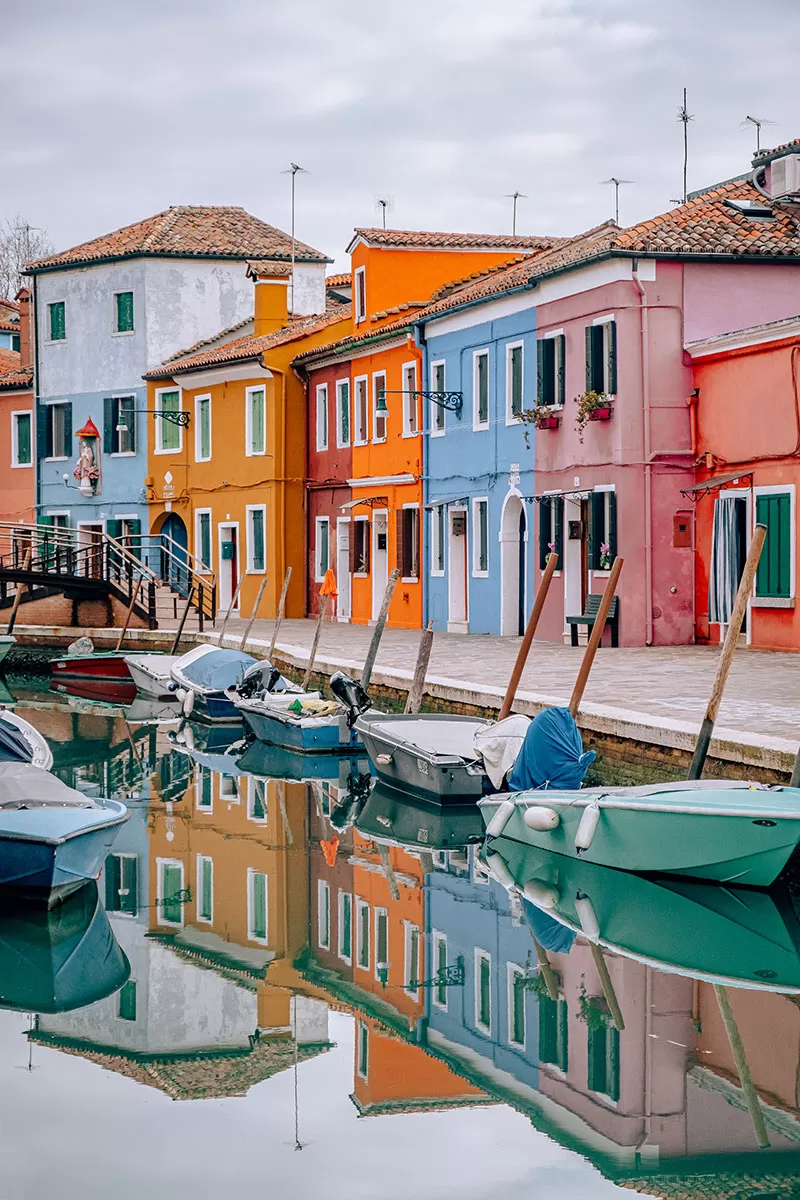
11. See the art covered walls at Trattoria Da Romano
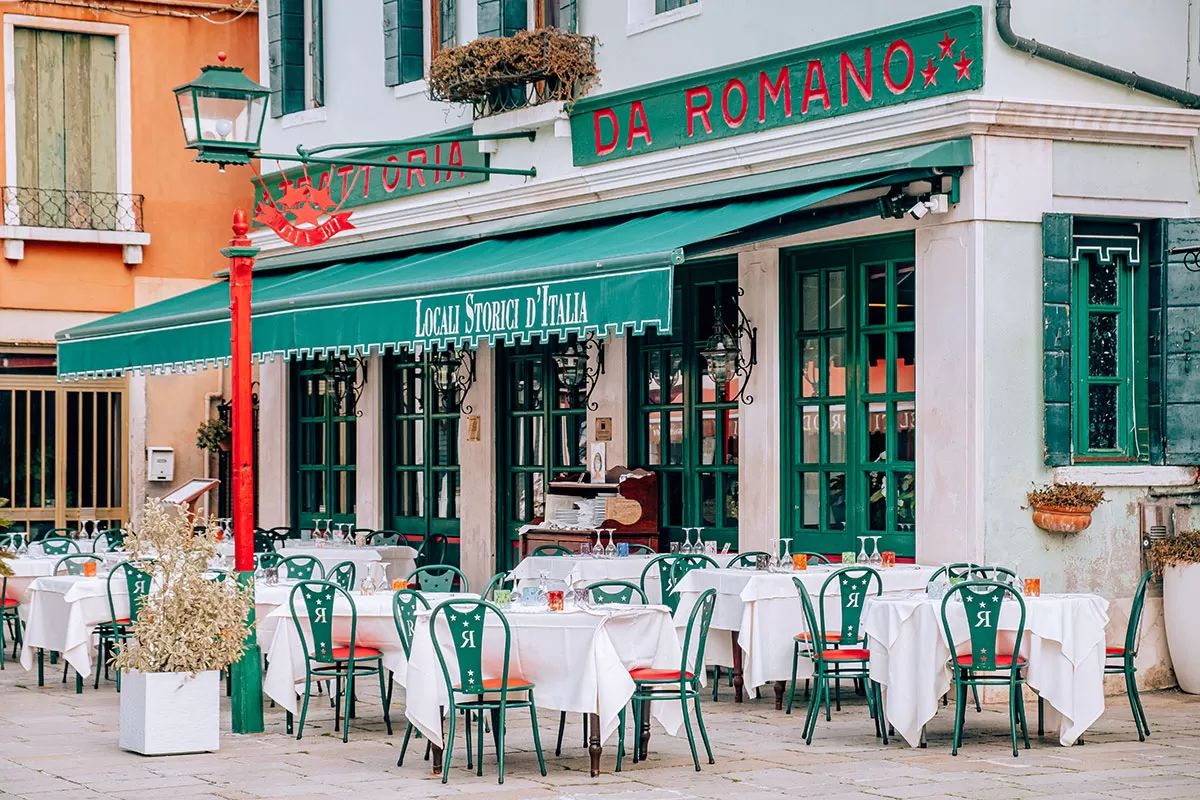 Trattoria Da Romano was another recommendation from local guide Silvia .Trattoria Da Romano is a recognised by the Association of Historical Places of Italy (Associazione Locali Storici D’Italia). When the Biennale in Venice was organised in 1895 to celebrate the 25th wedding anniversary of Queen Margherita and King Umberto, Venice draw the attention of many painters and artists. Sadly, many of these painters and artists were turned away from participating in favour of more well-known names. At which point they discovered Burano and Trattoria Da Romano.
Trattoria Da Romano was another recommendation from local guide Silvia .Trattoria Da Romano is a recognised by the Association of Historical Places of Italy (Associazione Locali Storici D’Italia). When the Biennale in Venice was organised in 1895 to celebrate the 25th wedding anniversary of Queen Margherita and King Umberto, Venice draw the attention of many painters and artists. Sadly, many of these painters and artists were turned away from participating in favour of more well-known names. At which point they discovered Burano and Trattoria Da Romano.
Its owner was an art lover and welcomes these artists, serving them “what was there”. It didn’t take long for Romano to become good friends with these artists. In return for his hospitality, one of the artists gave him a picture. Soon the entire restaurant was covered in over 450 frames containing paintings, and drawings.
In later years, other famous artists came to dine in Trattoria Da Romano and left testimonials in 26 “big books”. Among them include Vellani Marchi, Miró, Vedova, Carrà, De Pisis, Matisse, and de Chirico. Hemingway trained his hand here too which attracted other famous artists such as Chaplin, then Beatrice of Holland and Philip of Edinburgh.
Trattoria Da Romano specialises in Venetian cuisine with a menu that regularly changes according to the season. Its signature dish is the risotto di Gò, a traditional local dish prepared using goby fish (In Italian, it’s called ghiozzo), which was one fished throughout the lagoon. It’s so special it was even featured by Anthony Bourdain.
Use my guide to learn how to order your food in Italian
- Opening hours: Open for lunch and dinner. Closed Tuesdays and Sunday evenings. During winter it’s only open for lunch
- Address: Via San Martino destro, 221, 30142 Venezia VE, Italy
- Visit the Trattoria da Romano website
12. Enjoy an artisan gelato at Gelateria Crema
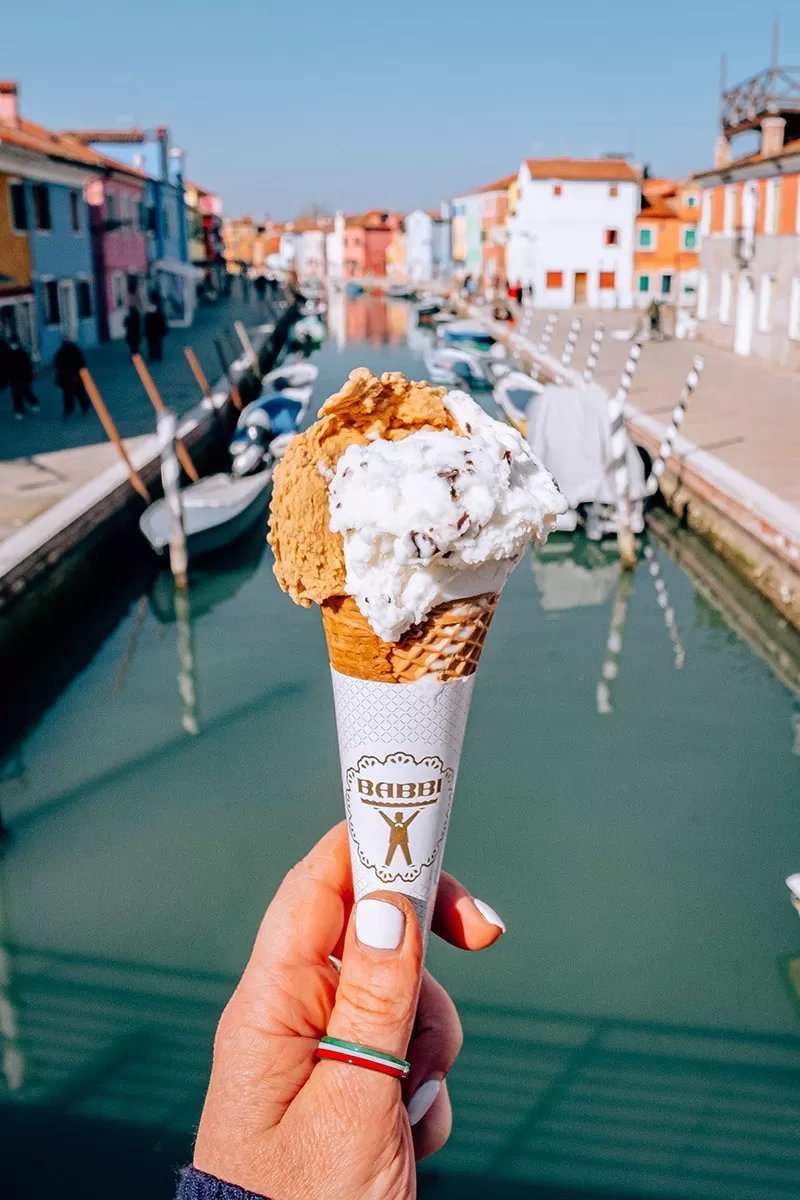 On the last day of my stay in Burano, this lovely gelateria opened up. I was told by the owner that the flavours will constantly change but you can expect some truly original and delicious flavours such as an alcoholic Aperol Spritz gelato! Learn how to order your gelato in Italian.
On the last day of my stay in Burano, this lovely gelateria opened up. I was told by the owner that the flavours will constantly change but you can expect some truly original and delicious flavours such as an alcoholic Aperol Spritz gelato! Learn how to order your gelato in Italian.
- Opening hours: Monday – Sunday 12 pm – 5 pm
- Address: Calle della Provvidenza, 230, 30142 Venezia VE, Italy
Allora, Eccoci qua! (So, there we have it!) My complete guide to the best things to do in Burano, Italy. Which one of these did you enjoy the most? Do you have any questions? Let me know in the comments below.
Don’t be treated like a tourist. Learn Italian with my 80/20 method
Travelling to Italy? Don’t be treated like a tourist! Live your best travel experiences and learn Italian for less than the cost of eating at a tourist trap restaurant or a taxi driver who has “taken you for a ride”. I’ve made it easy for you to master the Italian language so you can create lifelong memories as you mingle with locals, get local tips, avoid tourist traps, and make new friends. Who knows, you may be even be invited over for afternoon tea by a lovely Sicilian family like I was! Read all about how speaking Italian changed my life and check out my online Italian video course here.
Here’s what my students are saying:

I really enjoyed the Intrepid Italian course, it certainly exceeded my expectations. The learning methodology is great, and easy to follow and found that I progressed much faster in the last 4 weeks than I ever did on my own or using other language apps. Grazie mille Michele, I can’t wait until I can put my new skills into action! – Roma Small
Click here for instant access!
Don’t miss these Italy travel guides
- 33 Italy Travel Tips That Will Save You Time, Money and Disappointment
- 21 Best Things to Do in Venice, Italy (From Rooftop Views to Private Tours)
- Rome Tips and Tricks: 27 Things You Should Know Before You Go to Rome
- 29 Amazing Day Trips from Rome By Train, Car & Guided Tour
- Top 10 Things to Do in Rome That Aren’t On Your List
- Top 10 Absolute Best Views of Rome That Will Blow Your Mind
- Domus Aurea: Visit Rome’s Secret Hidden Palace
- Self-Guided Trastevere Walking Tour: Where to See Rome’s Most Beautiful Streets
- Absolute Best Things to do in Verona, Italy | 26 Must-See Attractions
- Top 7 Authentic Tours and Experiences in Rome [Run by Locals]
- Lakes, Mountains & Castles: 21 Best Things to do in Trento, Italy
- Italy Fun Facts: 126 Unique Things You Didn’t Know About Italy
- 36 Wonderful Things to do in Umbria, Italy (PLUS Map of Umbria)
- Where to Stay in Rome | Best Hotels and Best Neighborhoods to Stay in Rome
- Where to Stay in Verona: Best Hotels in Verona Neighbourhoods
- Where to Stay in Venice | Best Hotels in Venice for Every Budget
- 27 Best Things to Do in Trieste, Italy (PLUS Map, BEST Tours & Day Trips)
- THE 15 BEST Hotels in Trieste, Italy [2023 Edition]
- What it’s like Staying at DoubleTree by Hilton Trieste
Planning a trip and need travel insurance? Get a free quote from World Nomads here.
Like it? Pin it for later!
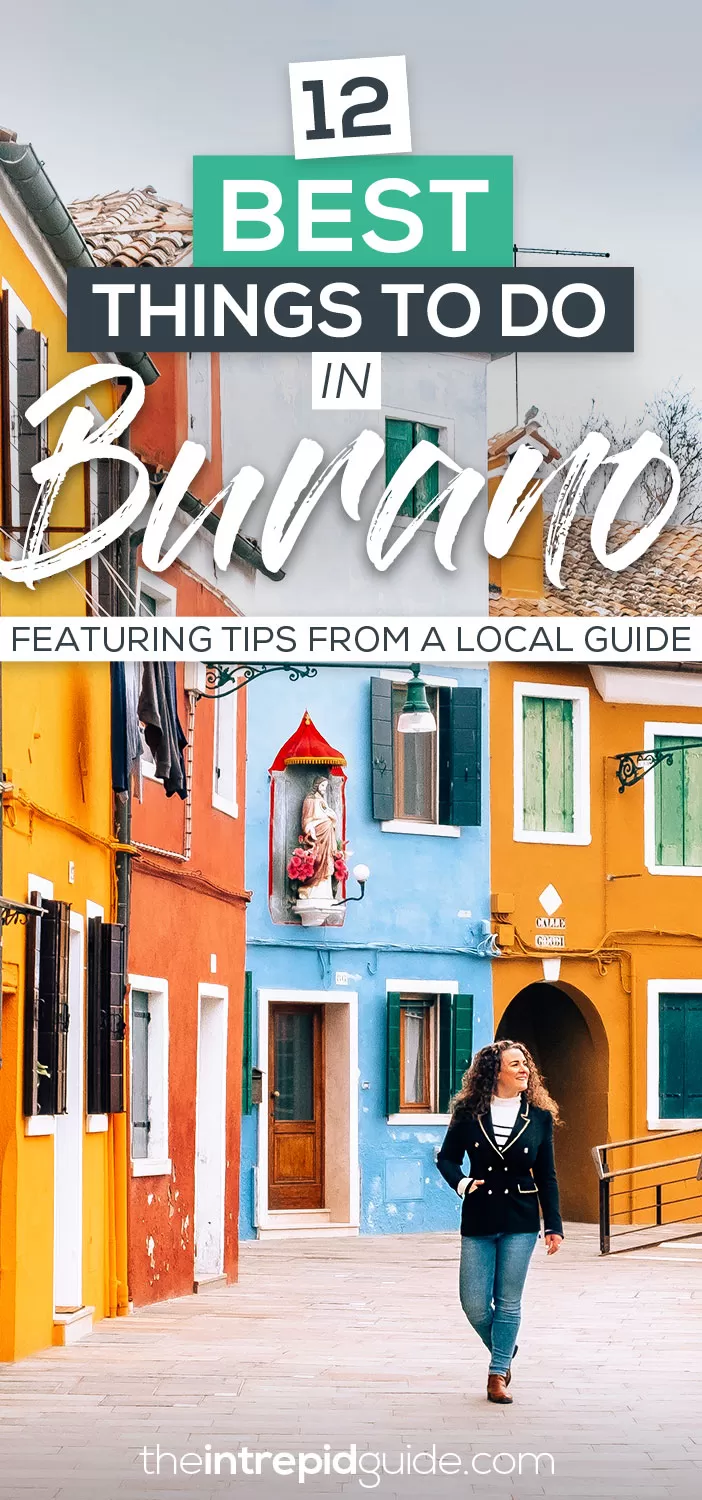
Over to you!
Have you visited any of these places? What other things in Burano would you recommend?
Let me know using the comments section below or join me on social media to start a conversation.
Thanks for reading and I hope you enjoyed this post.
Like what you see? Subscribe using the form below to have all of my posts delivered directly to your email.

